It was the beginning of day five and we were leaving Rome. We knew for sure that we wanted to see Pompeii while in Italy and all week we had been planning on renting a car Saturday morning to drive there from Rome. But after spending a few days in Rome (and witnessing all the crazy driving), I was not keen on driving at all. So we looked at the train schedule and realized we could get there much faster if we went by train. We also decided to book a private tour for Pompeii since we’d had such good luck with them so far. I found one on Trip Advisor that was all 5-stars with over a thousand ratings so I called them up and got it booked for 3:00 that afternoon.
Rome Train Station
Having visited the Roma Termini station the day before to travel to Nettuno, I felt more confident about taking the train to Naples. We decided we would check into a hotel in Naples, then get a driver or taxi to take us to Pompeii, then head back to Naples to spend the night. We had breakfast at our hotel for the last time, checked out, and got to the train station with plenty of time to spare. For this trip, I had booked us on a high speed rail with more comfortable seats (and air conditioning!). I searched the Departures board for Naples and the time we were leaving and saw that it was departing on Track 11… perfect. We boarded the train but it looked just the train we were on the day before… not a high speed train. I didn’t see any assigned seats and it was definitely not air-conditioned. So I pulled up my online tickets on my phone and asked a passenger if we were on the correct train… no, we were on the wrong train! Yikes!!! Apparently multiple trains depart for the same city at the same time. Whew, that was a close call.
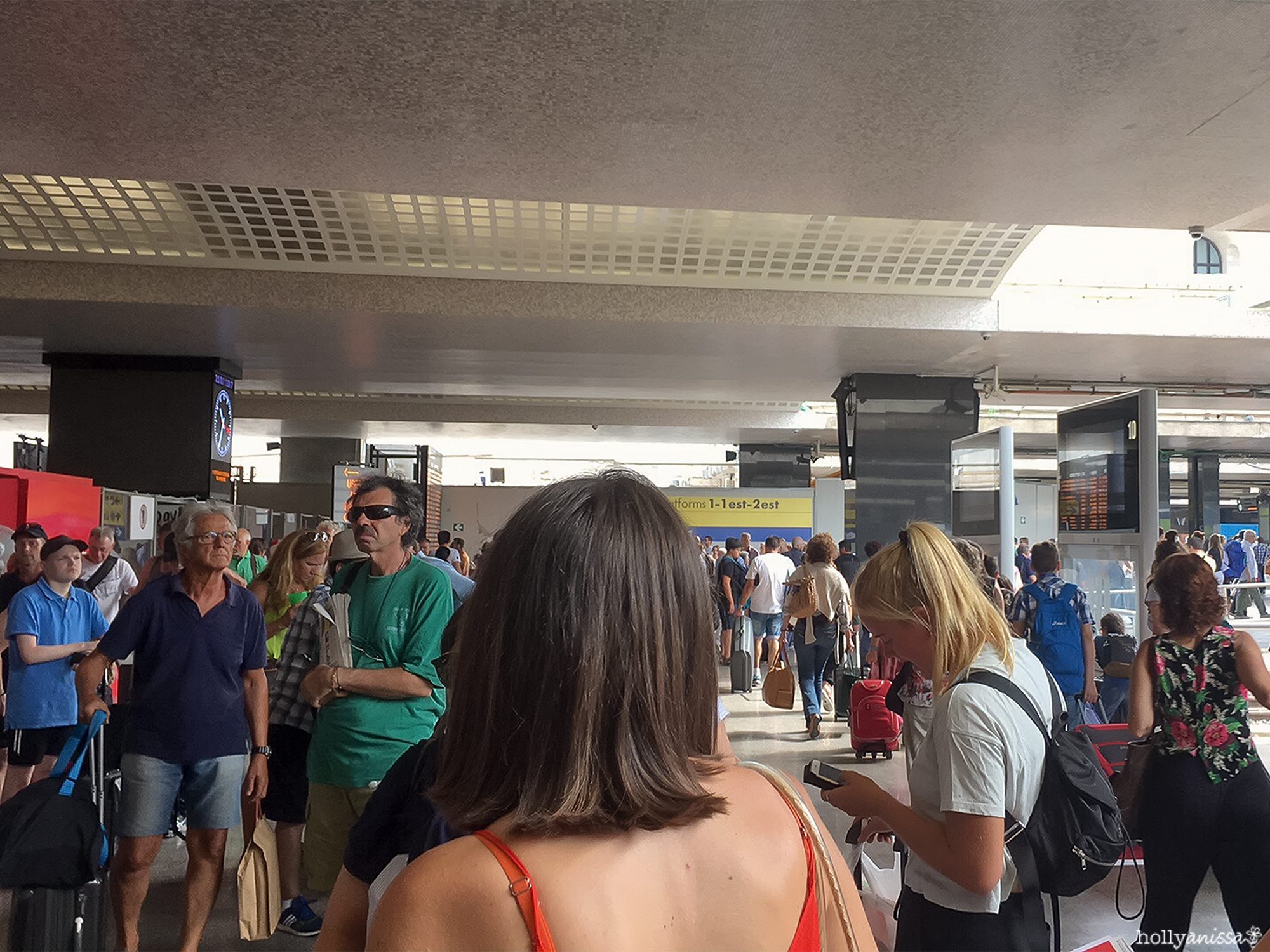
iPhone 6S+
So back to the Departures board we go (it’s too small for Curtis to read it, so I’m solo for getting us to the correct train… no pressure or anything). I looked up the actual train number which is similar to an airline flight number and found that our train was delayed by 15 minutes. So we had to stand in a crowd of hundreds of people waiting for a track to be assigned. Curtis got this shot of me looking less than amused by the crowd and heat. Then Curtis had an urgent need to use a bathroom but there was no bathroom in sight. Finally he could no longer hold it and left me with all the bags in search of a bathroom. Wouldn’t you know less than 5 minutes after he left, we get our track assignment. I wait and wait and wait, growing more and more anxious as our departure time approaches. Finally I text him, “Hurry!” and he comes running back… without having used the bathroom. Apparently the stalls require a euro to open and he didn’t have one on him. Ugh! So we rush over to track 2 to meet our train, thinking he will just use the bathroom on board, and… it’s not there yet. Sigh. Poor Curtis. He leaves again in search of a bathroom and then our train finally pulls into the station. I wait while watching all the other passengers board, trying not to panic. Curtis returns again without having used the facilities (turns out it was outside of the station on this side), boards the train with a most pained expression on his face, and finally gets to go. Poor guy!
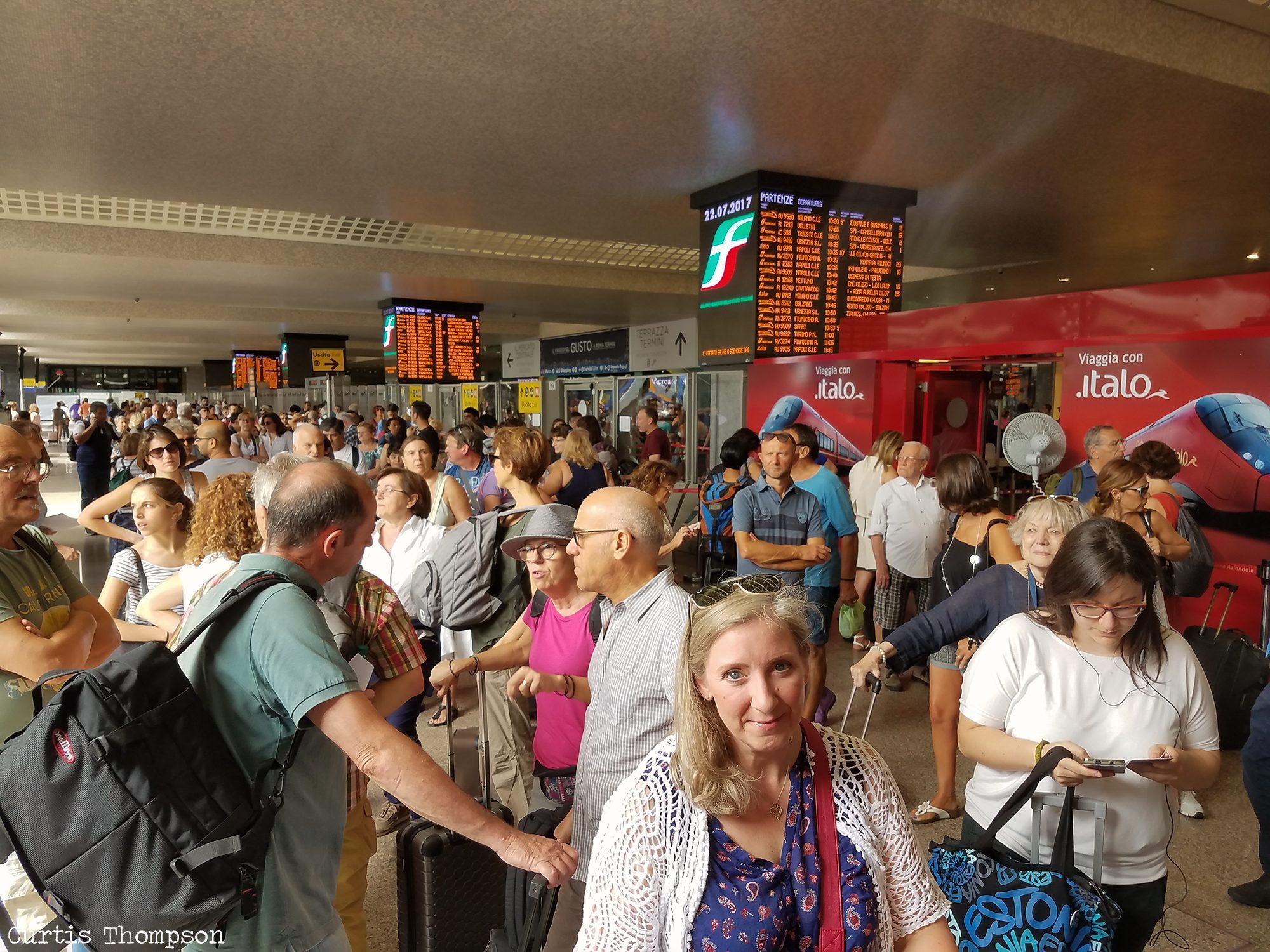
Samsung Galaxy 6
Goodbye Rome
As we pulled out of Rome, I felt a little sadness at saying goodbye. The time we spent in Rome was wonderful and I couldn’t imagine anything else being better. But just wait! Our train was quite comfortable and we were in Naples in an hour and a half… the train went nearly 200mph!
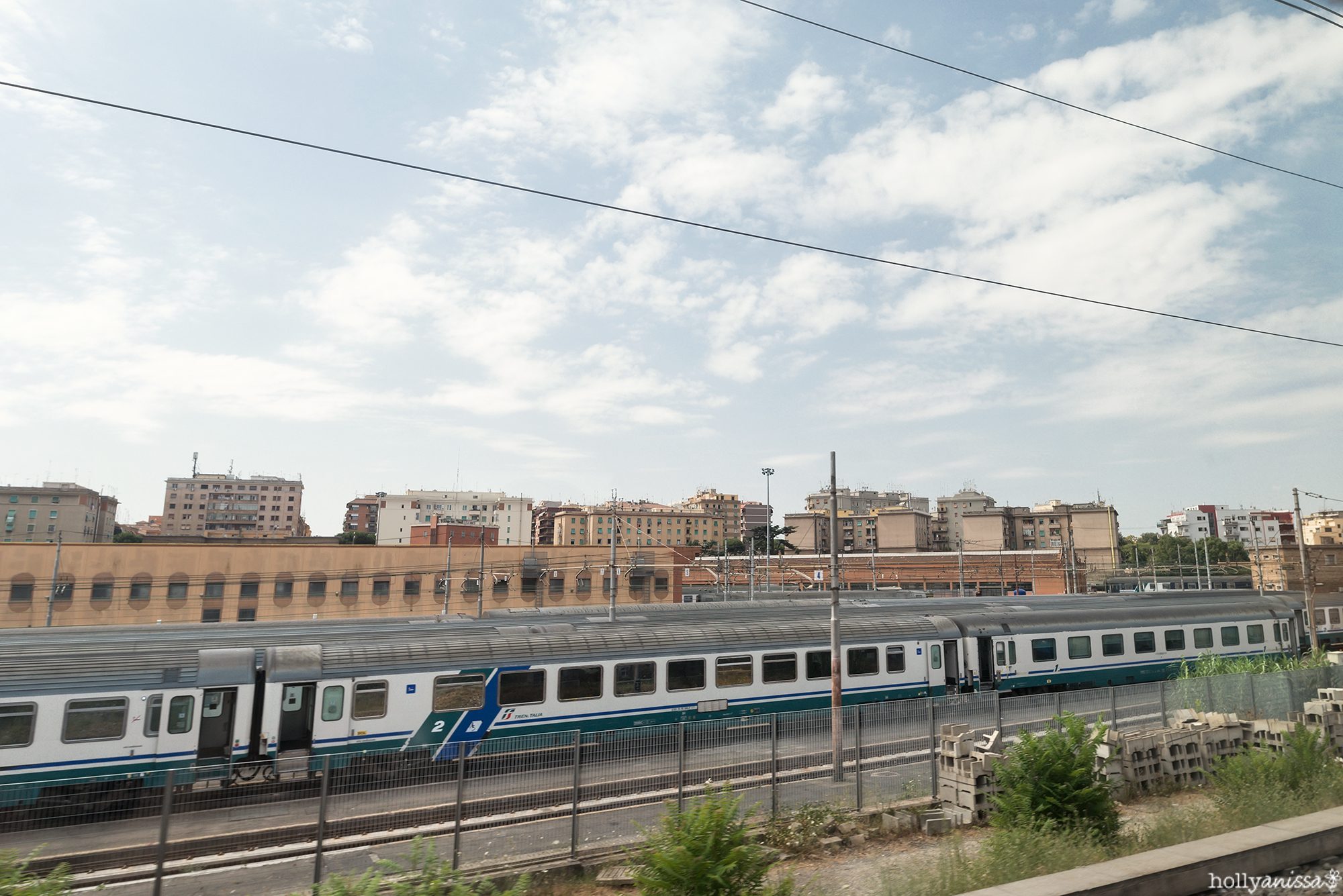
Nikon D750 | 20mm | f/7.1 | 1/500 | ISO 400
Hello Naples
So our first impression of Naples in the train station was chaos. There were no signs for the exit, no taxi station, and no clear idea of where we were supposed to go. A man approached us asking if we wanted a taxi and said it would be 30 euros. Robbery! I told him, no, we would to pay more than 20 euros to get to our hotel which was less than five miles away. He left in a huff then came back after we stood for a while looking lost and offered to take us for 25 euros. I told him 22 and he had a deal, so he begrudgingly agreed. Once we got to his taxi, I was appalled. It was filthy, tiny, beat up, and not air-conditioned. Ugh. And he drove like a maniac. I thought Rome was bad, ha! Everyone drove horribly. Naples was an armpit. Graffiti and trash were everywhere. I was glad to get to our Americanized hotel and get checked in. When we got to our hotel, the taxi driver told Curtis it was 25 euros… yes, he cheated us out of 3 euros. Grrr. The hotel elevator barely fit me and Curtis, and it was one that you entered your floor number on the outside, then waited for one to open. On the inside, there were no buttons. It was disconcerting. We got up to our room and it was just okay. It had a bed and a bathroom. The whole place smelled funny. It was nothing like the suite we had just checked out of. But it was another Marriott property, and Curtis got to rack up more hotel points. This was the view out of our hotel window. Not bad, eh?
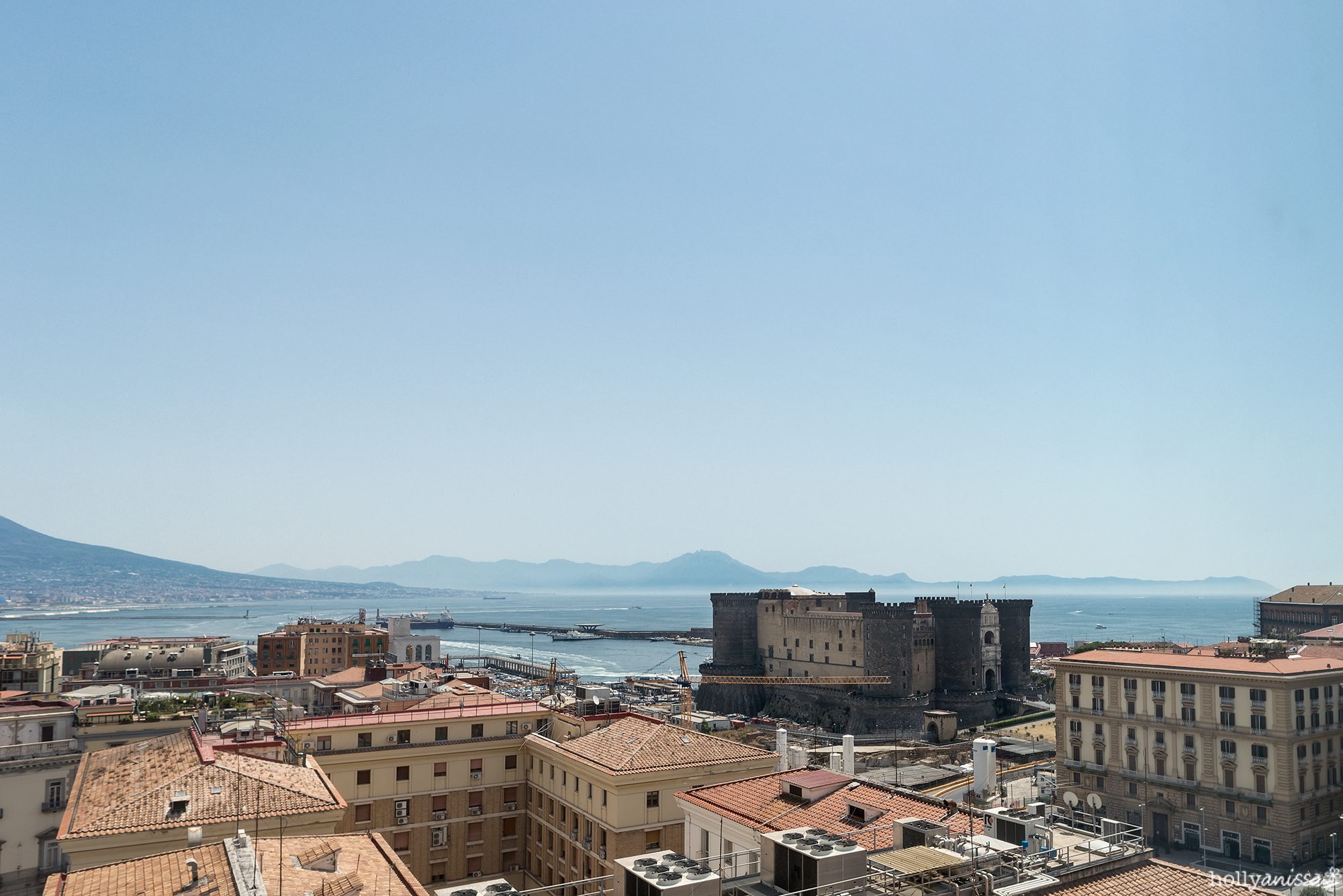
Nikon D750 | 20mm | f/7.1 | 1/500 | ISO 100
Cracking Himself Up
We went back down to the lobby to talk to the receptionist about getting a driver to take us to Pompeii. The hotel said they could arrange it for us and it would arrive in about an hour, so we went out to find some lunch. We ended up eating at Le 3 Sorrelle Trattoria e Pizzeria and the food was pretty good. The tiny restaurant was a few blocks from our hotel and was one of the few places open on this Saturday afternoon. We got back to the hotel, popped back up to the room to grab cameras (funny story, we got on an open elevator not knowing it was someone else’s, unknowingly got off on the wrong floor, and tried to get into someone else’s room… whoops!), then went down and met our driver. We were pleased to find that we were traveling in a huge air conditioned comfortable passenger van. I had been making Curtis take selfies with me everyday so I asked him for one in the van too. He kept making goofy face after goofy face. I threatened to use one of those photos and he kept laughing… he was cracking himself up with his antics. What a cutie… it was nice to see him relax and have some fun. I don’t even care that this is so out of focus.

iPhone 6S+ | 2.7mm | f/2.2 | 1/17 | ISO 50
Pompeii Tourist Area
We arrived in Pompeii about 15 minutes before our tour was supposed to start so we wandered around and did a little shopping. I wanted a straw hat to protect my face from the sun (there was not a cloud in the sky!) and Curtis wanted a lemon ice to drink. This was the little touristy shopping area near our meeting point. I was surprised by how few people were around.
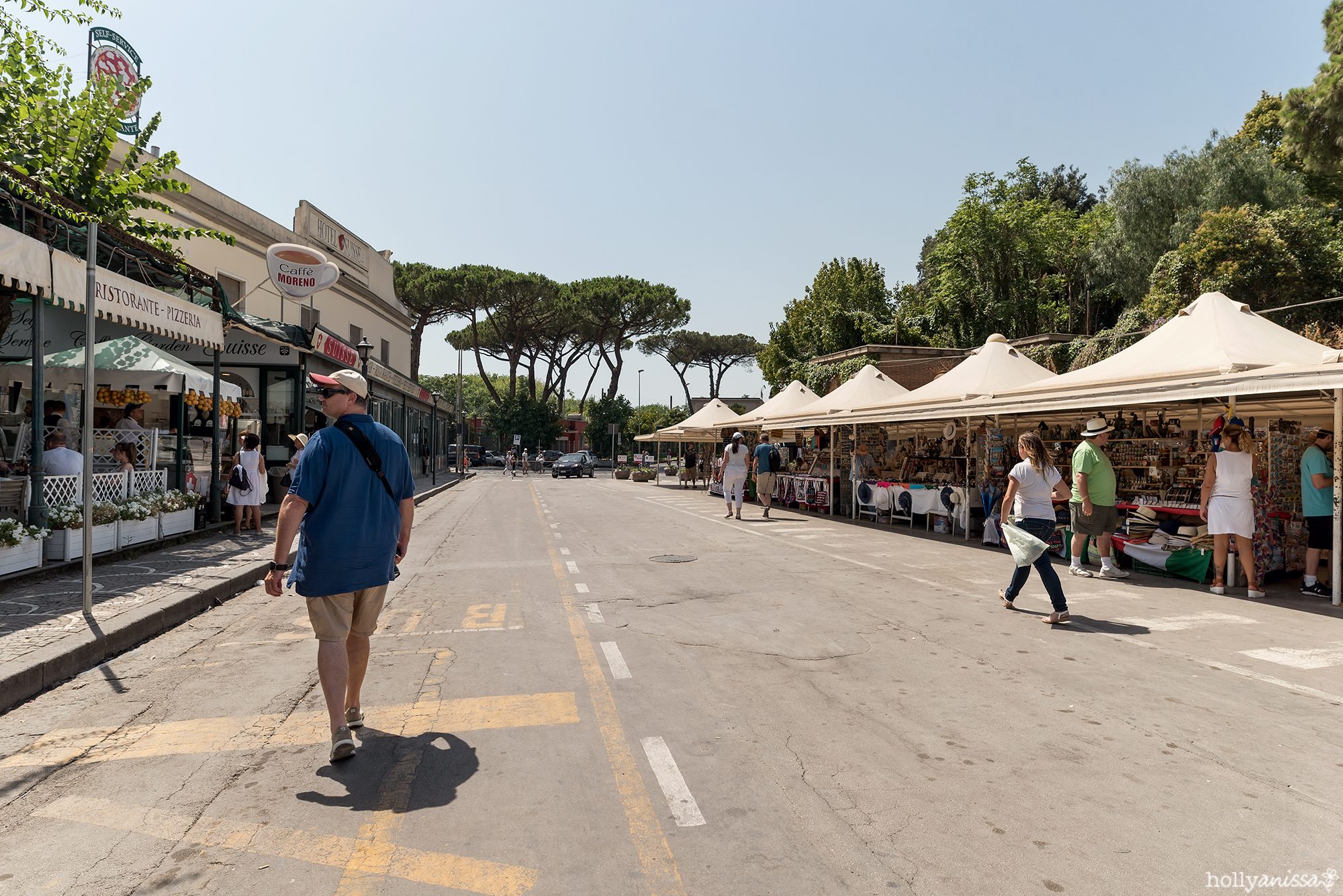
Nikon D750 | 20mm | f/7.1 | 1/500 | ISO 100
While I was looking for just the right hat, Curtis suggested this Roman helmet. He made me stand there while he took a photo and laughed at me. “See what I have to put up with?” I said to the sellers.
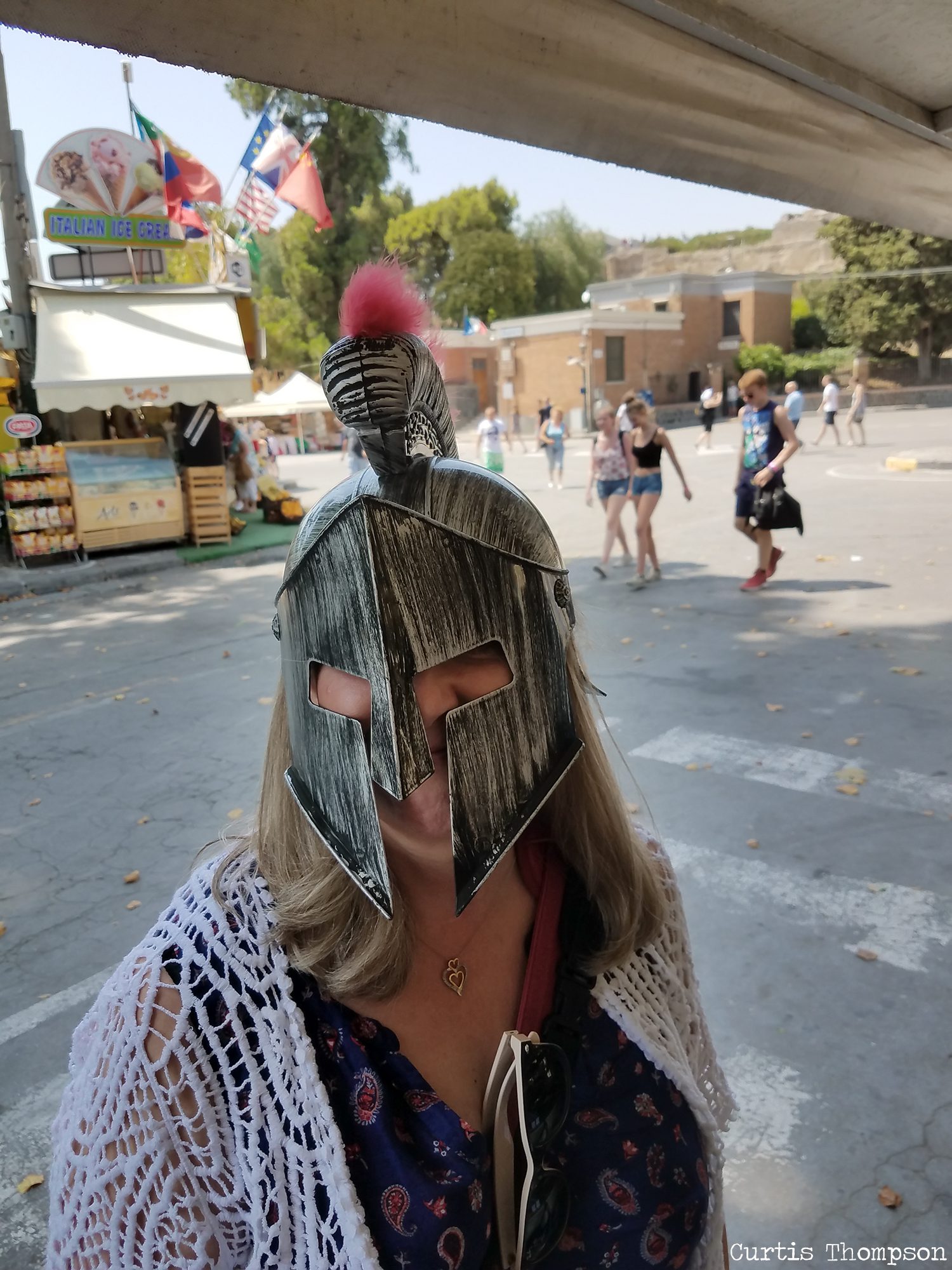
Samsung Galaxy 6
First Look at Pompeii
We found our tour guide from Tours of Pompeii with Lello & Co. (this was the Trip Advisor tour that was all 5-stars with over a thousand ratings)… I was expecting a woman, so this was surprise number one. When the man introduced himself as Lello, that was surprise number two. I didn’t realize we would be getting the owner of the company as our tour guide! He was a little younger than us, had an air of wealth and nonchalance, and had a heavy Greek accent. Lello is an archeologist and used to teach history. He has a true passion for Pompeii and it was apparent right from the start. He was adorable and called me “Hoe-ly” and Curtis “Curtin.” When I corrected Lello that it was Curtis, he then called him “Curtins” for the rest of the tour! Our third surprise was that this was a totally private tour, it would just be the three of us. Yay! Lello talked about how this time of day was his favorite because there weren’t as many tourists. As we began walking into the city, everyone greeted Lello by name. This was our first view of Pompeii. I really had very little knowledge about this place other than it was covered by volcanic ash and it was really old. Mt. Vesuvius erupted in AD 79. It was first discovered when an underground channel was being built in 1599. In the 1700s, farmers began drilling down and not finding earth… they found volcanic ash. Formal excavation began in the mid 1700s. Lello said that Mt. Vesuvius erupts about every 2000 years and it’s due for another eruption soon. And there is no centralized plan to evacuate the area. Holy moly. That is scary.
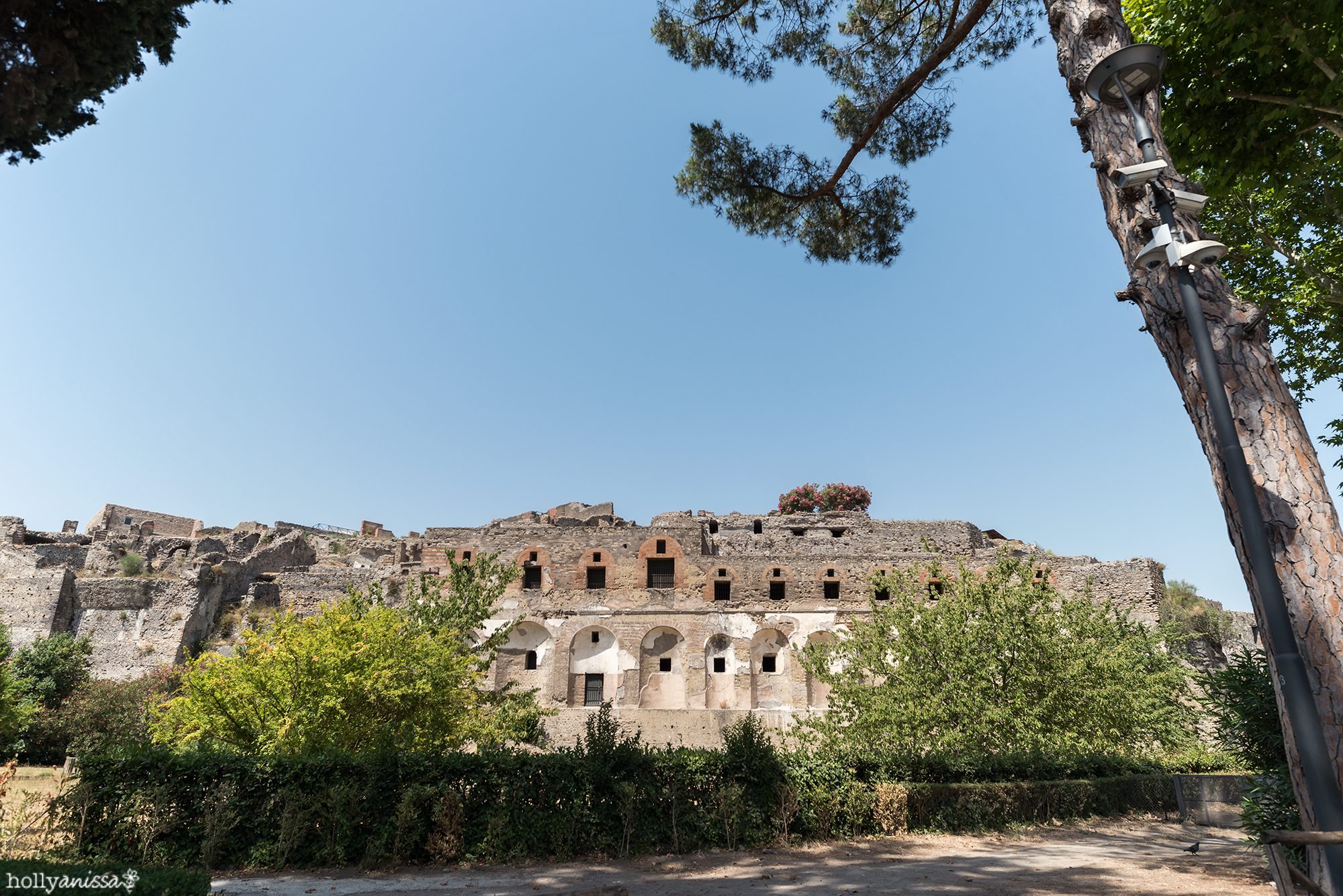
Nikon D750 | 20mm | f/7.1 | 1/500 | ISO 100
Gladiator Training Area
One of the first things we learned was that Pompeii was home to more than 10,000 people and was considered a Las Vegas-style playground for the rich and famous. Because it was on the coast of the Mediterranean Sea (now it is inland), it had a large port. So the city saw tourists from both land and sea. The first area we saw was a gladiator training school. It had a large open yard surrounded by a square of enclosed rooms. Lello told us that this school used to train the most famous and best gladiators in ancient times.
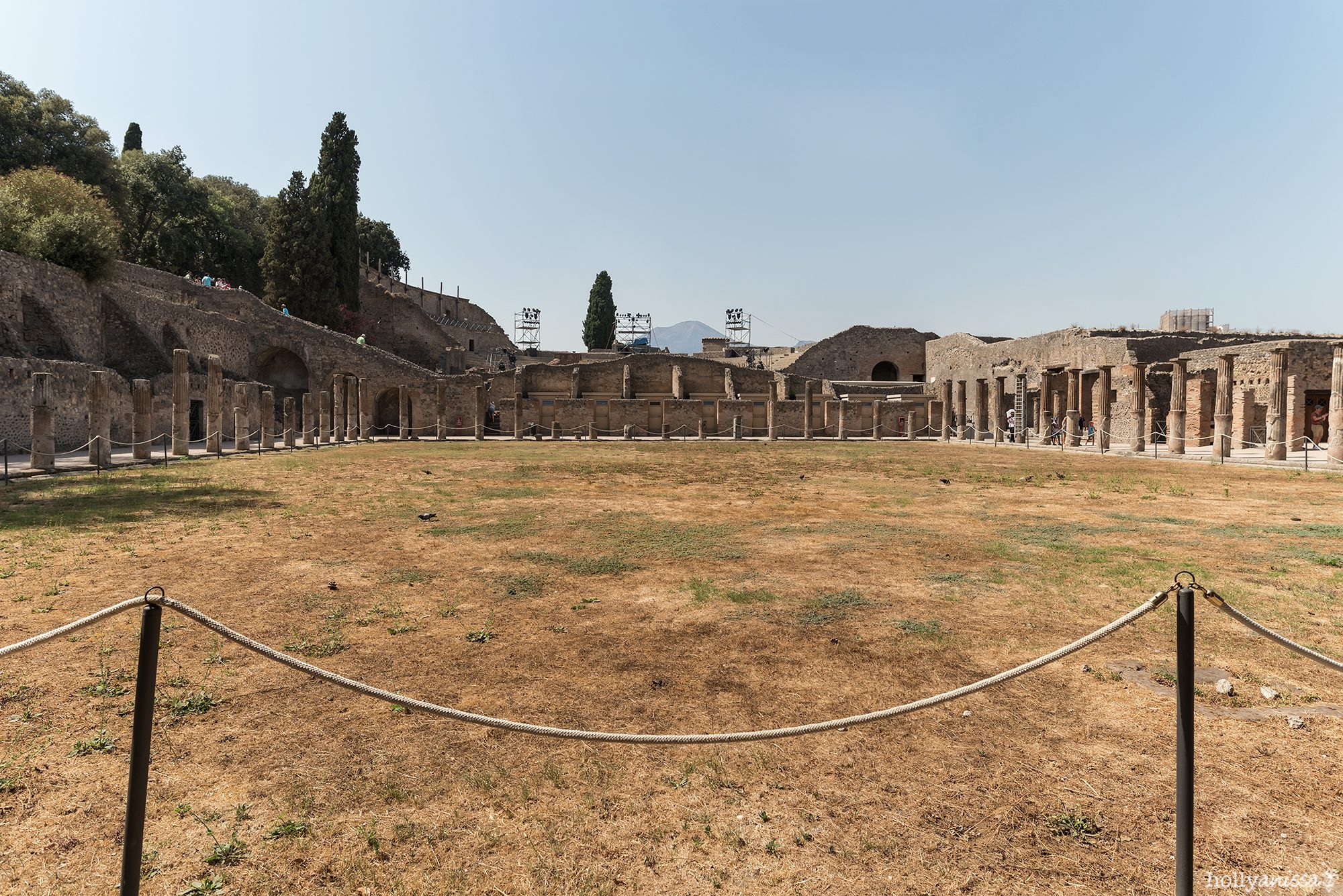
Nikon D750 | 20mm | f/7.1 | 1/500 | ISO 100
Curtis’s version (or should I say Curtins’ version!).
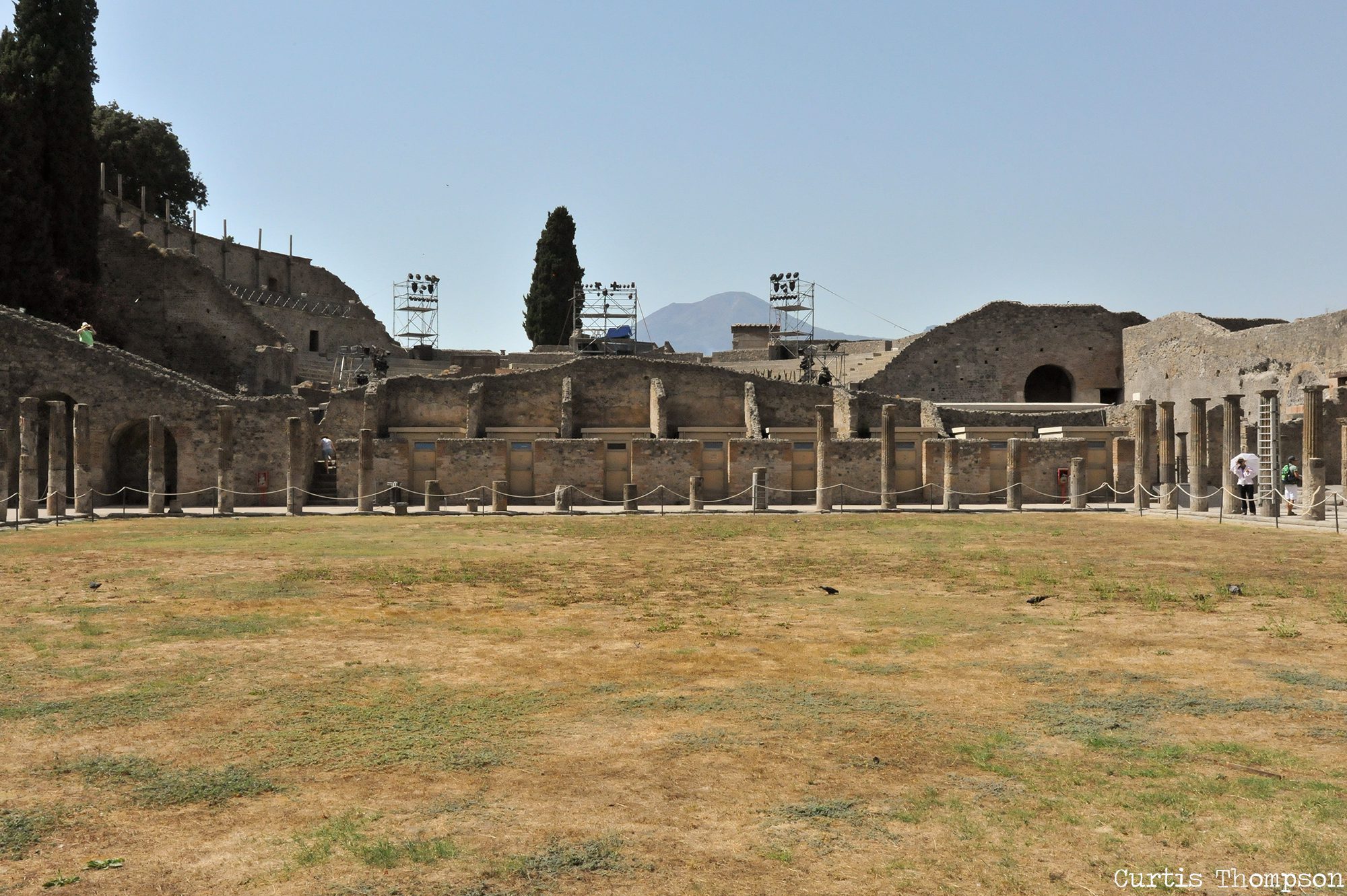
Nikon D700 | 35mm | f/22 | 1/1250 | ISO 4000
Slave Cells
The reconstructed doors to the enclosed rooms were small. People were shorter and the doors were only five feet tall. You can see notches above the doors ~ those were for struts supporting a second story of rooms. Lello told us that these were slave cells also known as the gladiators’ barracks. They would put many men in these small rooms to live in when not training.
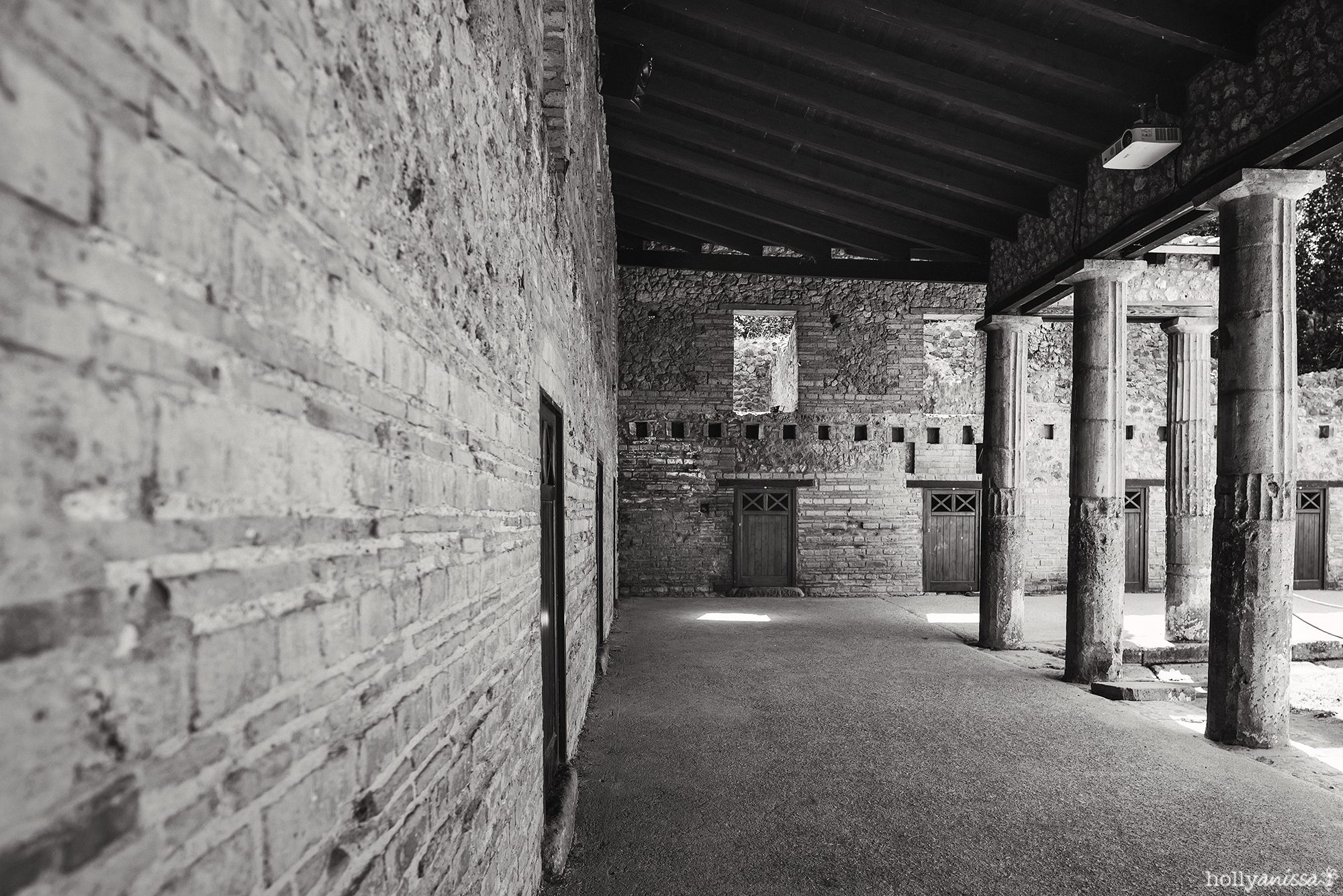
Nikon D750 | 20mm | f/3.5 | 1/200 | ISO 100
The Theater
Next we viewed the large theater. The design was brilliant, from the stone they used to construct it, to the stage, to the seating. First Lello told us about the seats. The elite sat closest to the stage, just like at the Colosseum. These seats were constructed of smooth marble. Next were rows of stone seats followed by seven sections surrounded by a circular corridor. In total, nearly 5,000 spectators could watch a performance. They had a canopy as well to protect against the sun and bad weather, just like at the Colosseum. The stage was made from smooth travertine and one stone was a different color. Lello had me stand on this colored stone and talk in a normal voice. Then he had me step off the stone and talk again. That particular spot on the stage massively amplified the actor’s voice… it was remarkable! The woman with the yellow umbrella is another tour guide.

Nikon D750 | 20mm | f/6.3 | 1/500 | ISO 100
Curtis’s version.
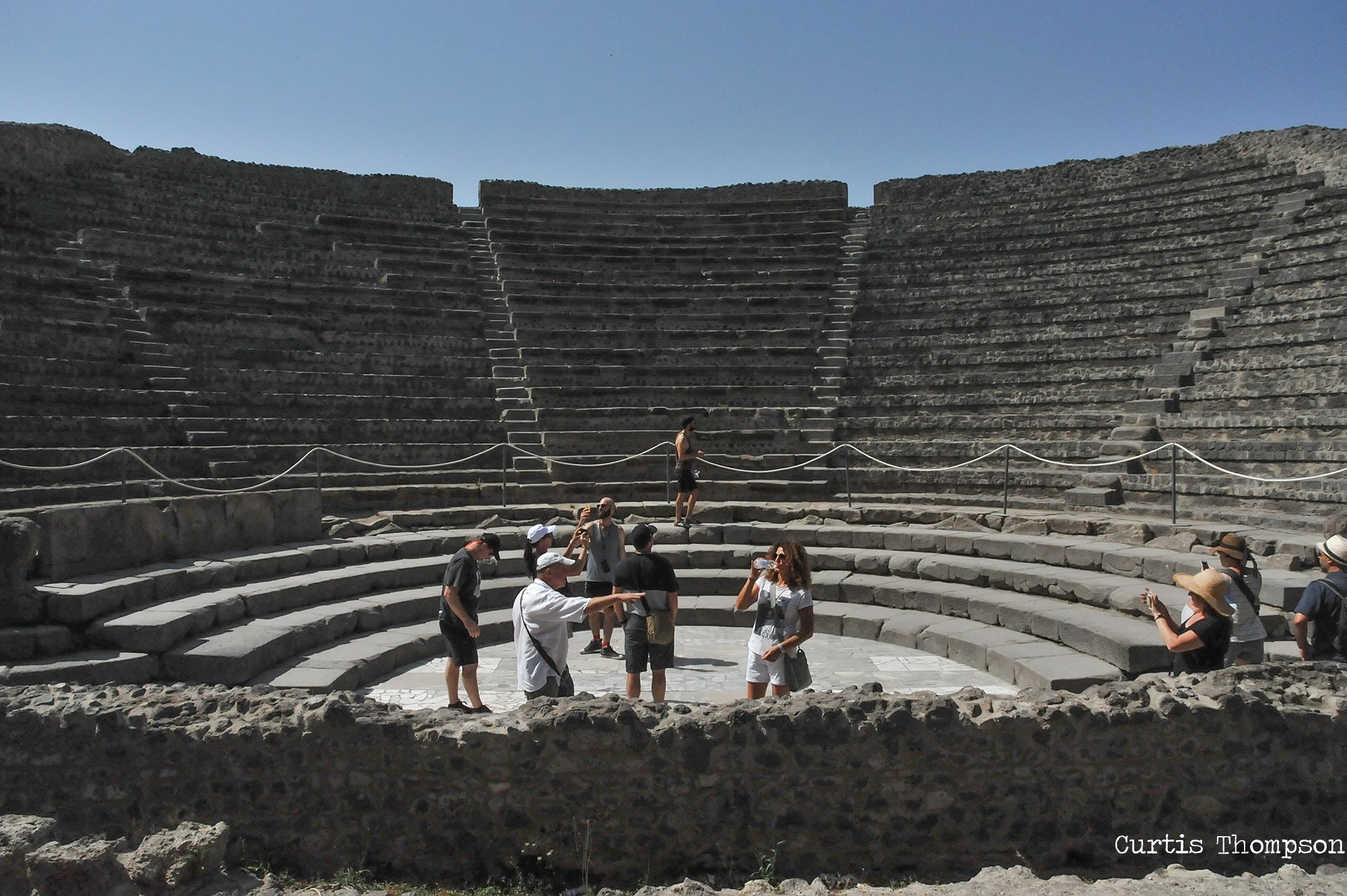
Nikon D700 | 24mm | f/22 | 1/3200 | ISO 4000
Curtis also got this close-up of the first class section delineator. The stone sculpture indicated a divide between the class seating.
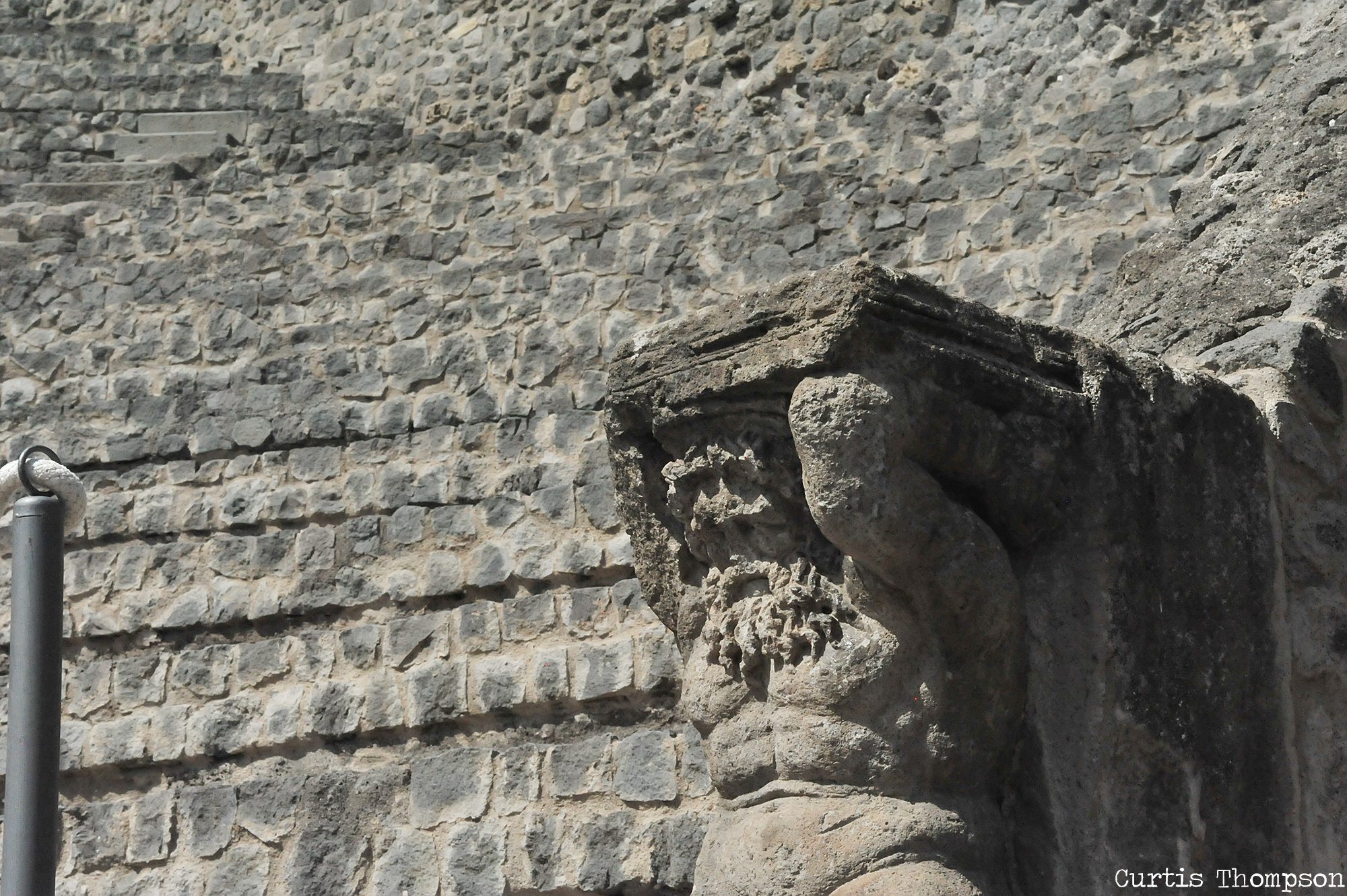
Nikon D700 | 70mm | f/22 | 1/3200 | ISO 4000
We then walked into the city and saw our first road. Curtis got this shot of one of the main entrances into the city. We were in the poorest section, do you see how the street slopes down? That was to allow water and waste run-off, thus the poorer people lived down and the richer lived up. See those three round stones at the end of the street? Pompeii had a devious system to get more tourist money. They would only allow carts with a certain width of wheel base to have access… which was not the standard cart width. If your cart could not fit between those stones, you had to rent a Pompeii cart to get around.
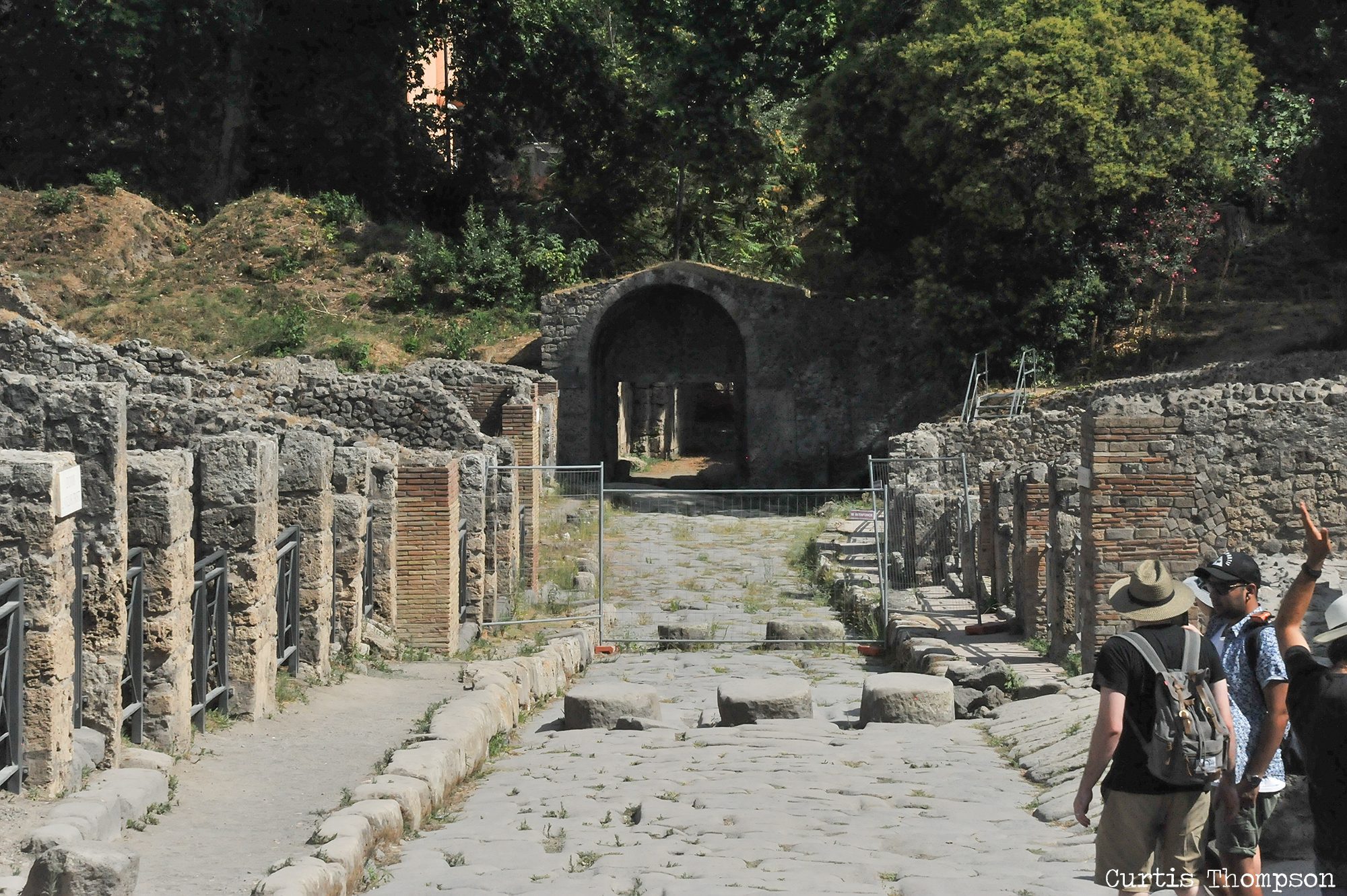
Nikon D700 | 120mm | f/22 | 1/3200 | ISO 4000
Hot and Cold
This image is of a small market shop. Those holes held large vases made out of terra cotta. Soups, drinks, anything liquid, could be kept hot or cold to sell to customers. Some of the markets had living quarters directly behind or above the shop. These storefronts were small with small living quarters but as you make your way up into the city, the markets and their living quarters become quite large. Later we would see a baking oven that looks just like a modern day pizza brick oven.
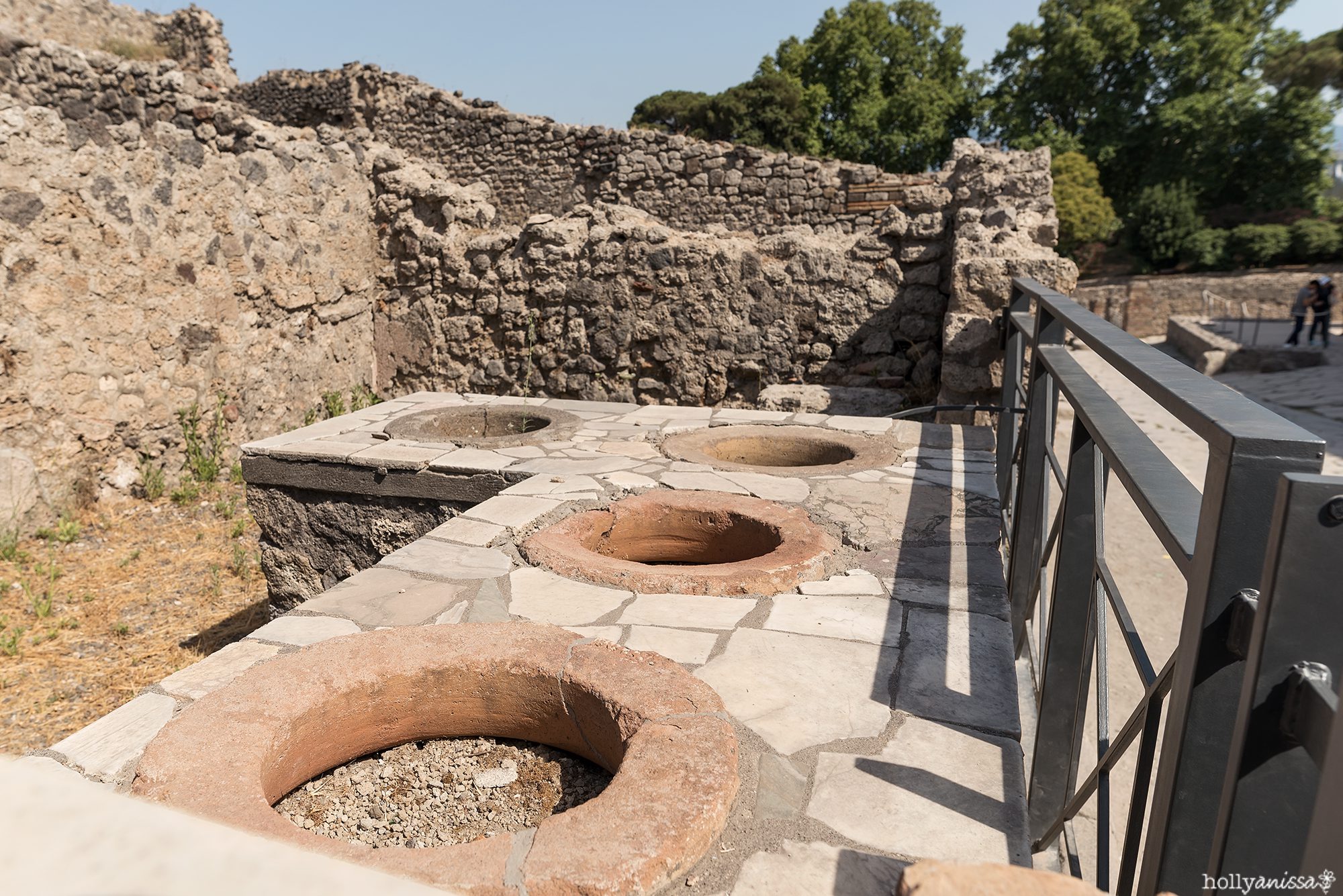
Nikon D750 | 20mm | f/6.3 | 1/500 | ISO 100
Pompeii Street
Pedestrians stayed on the sidewalks that flanked the streets so as to not step in water, urine, or waste. Horses and carts would have run of the streets and some streets you can still see wheel ruts in the cobblestones. There are small holes drilled into the edges of the sidewalks. This is when Lello began his quizzing… “Do you know why those holes were there?” I guessed to tie up horses which was correct! There were also smaller stones scattered across the streets from time to time to allow pedestrians to cross without getting wet or dirty.
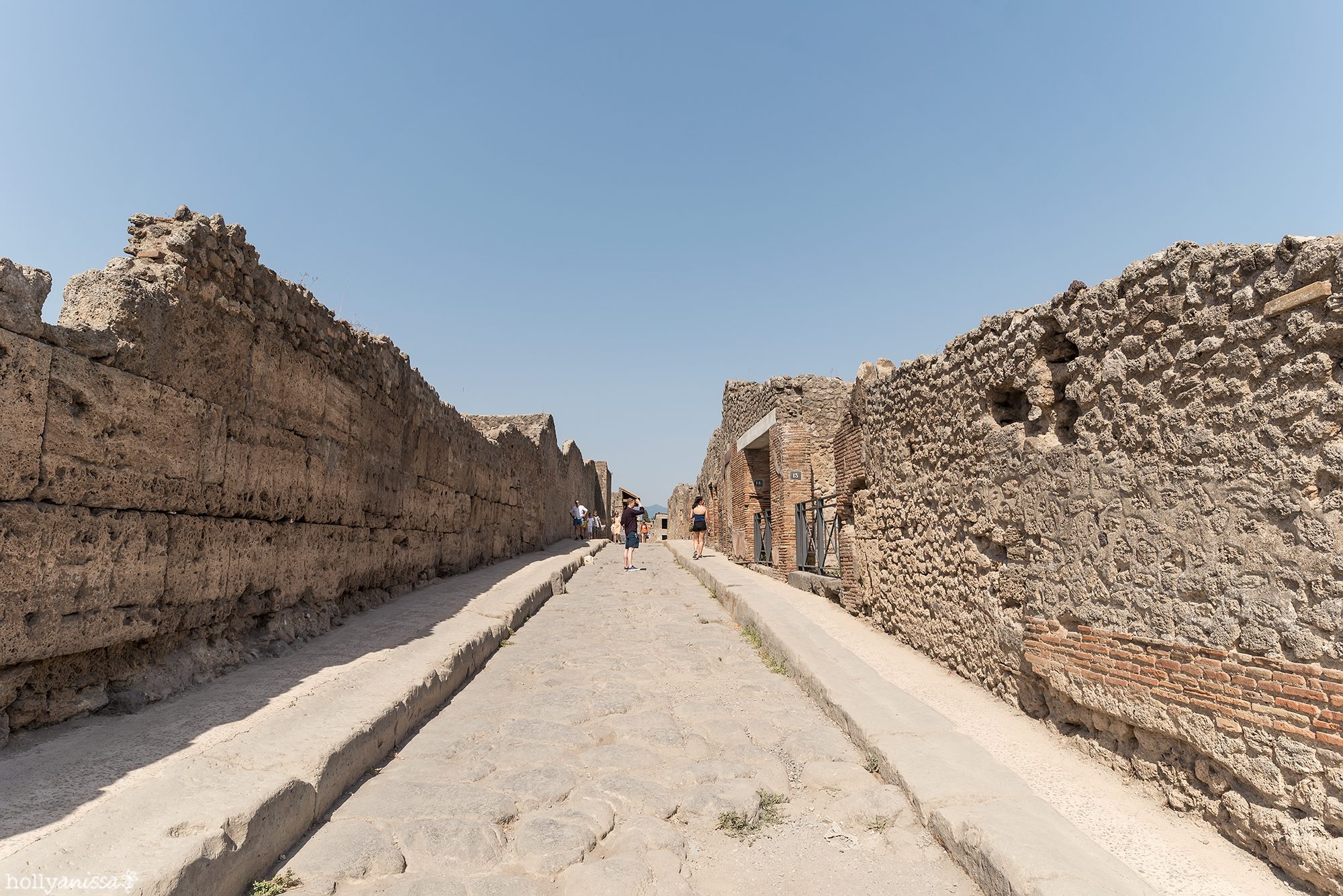
Nikon D750 | 20mm | f/6.3 | 1/500 | ISO 100
Bigger Than I Thought
As we began to explore the city, I was surprised by how large it actually is. Covering 170 acres, 2/3 of Pompeii has been excavated so far. The city is laid out in a north/south and east/west grid pattern. This is up two blocks from where we entered looking down. We are on Via Stabiana.

Nikon D750 | 20mm | f/6.3 | 1/500 | ISO 100
We shot the same image! Curtis listened intently as Lello talked, I would shoot and listen to him speak. When Lello finished his dialogue, he would go immediately onto the next thing, saying, “So are you ready to see something even better? Let’s go!” so Curtis didn’t end up taking many shots. He got left behind too many times so he gave up.
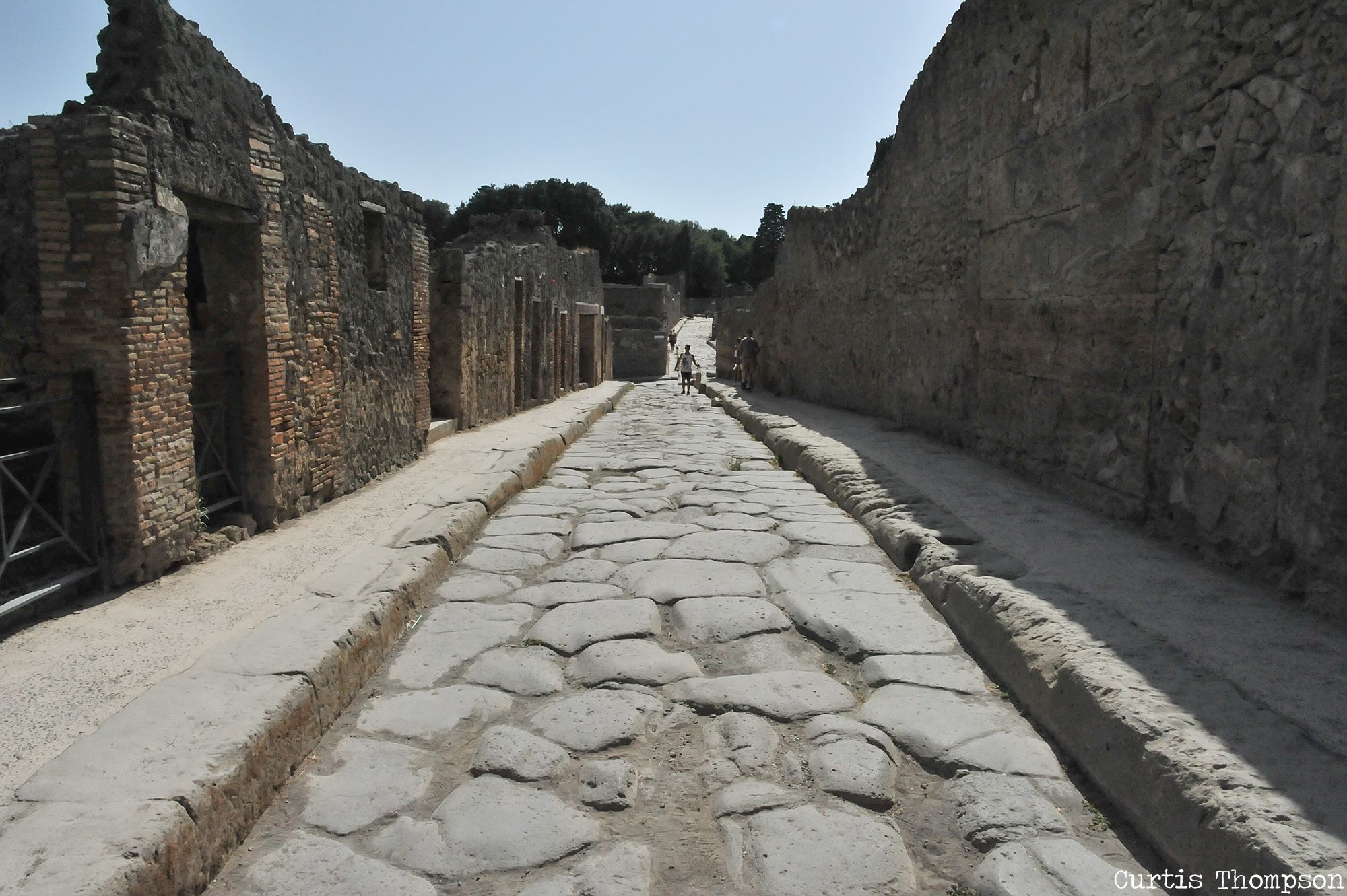
Nikon D700 | 24mm | f/22 | 1/3200 | ISO 4000
Side Street
Between major blocks were smaller side streets. You can still see a stepping stone to cross the road.
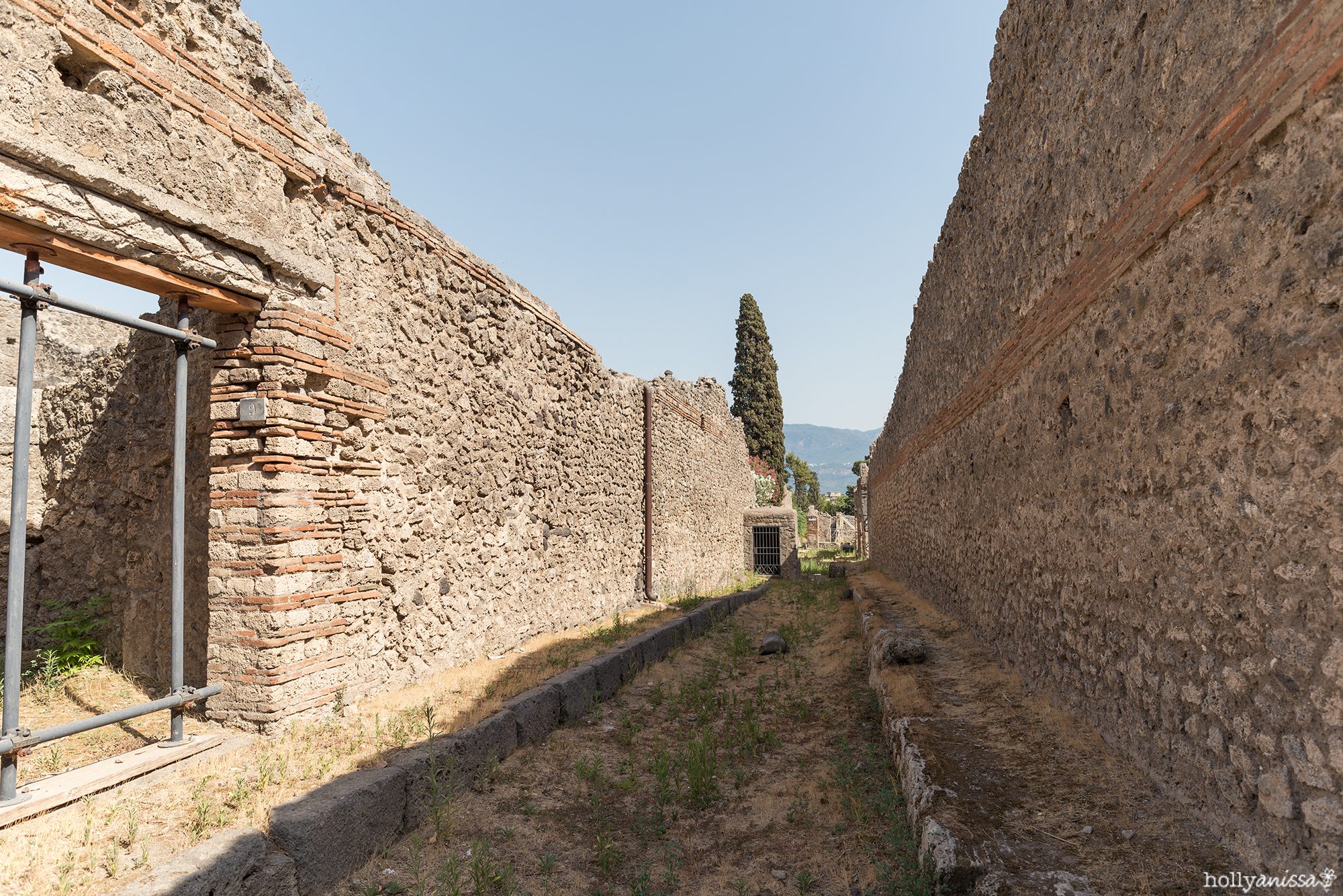
Nikon D750 | 20mm | f/4.5 | 1/500 | ISO 100
Street Sign
Being in the city with streets that all look the same, people would get lost. Pompeii‘s version of a street sign was to use decorative stones to mark street corners. See the circle near the top of the building with inlaid tile? That’s the street sign!

Nikon D750 | 20mm | f/6.3 | 1/500 | ISO 100
Subtle Details
Lello explained to us that all homes were built with exactly the same layout. Some were larger than others but all had the same architecture. One way for families to distinguish their home from their neighbor’s, and to show off a little wealth, was by what kind of tile, stone, and molding was used on the outside, entrance, and inside. This door had a bit fancier doorway and molding, so this family was probably middle class.
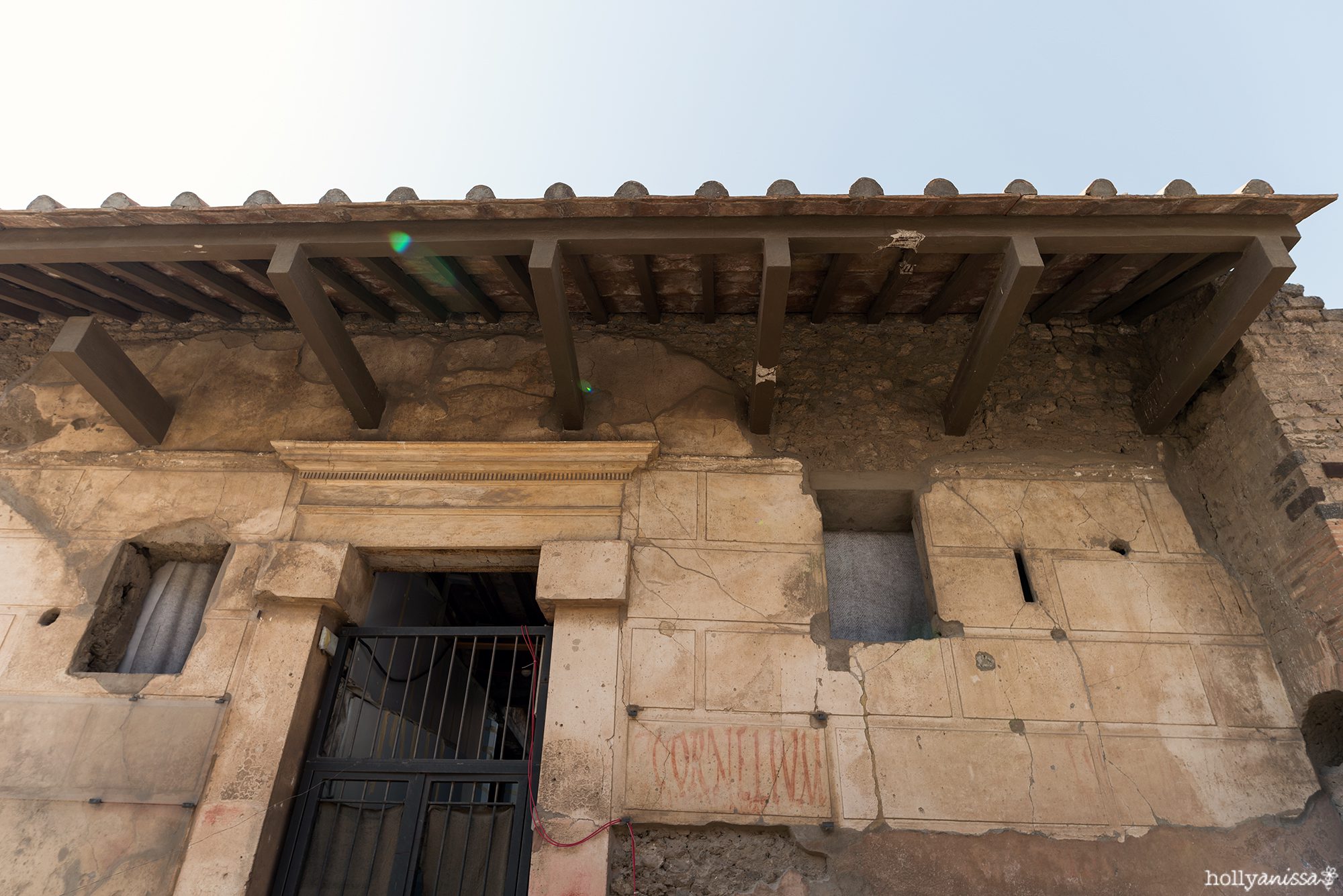
Nikon D750 | 20mm | f/4 | 1/500 | ISO 100
Casa del Menandro
Next we got to explore inside of a home. Lello called Casa del Menandro “his house” because it was most likely upper middle class and equivalent to what he would own today. The entrance is quite tall and has a small foyer just inside the gates that leads to a large open area inside the home.

Nikon D750 | 20mm | f/6.3 | 1/500 | ISO 100
Beautiful Color
Just inside at the edge of the main open room, I stopped and looked left. The first room on the left is a bathroom and the room in the corner (where you see the gate) is the kitchen. I was surprised by how colorful the inside of the house way. Lello said families would paint color into the plaster before it dried.
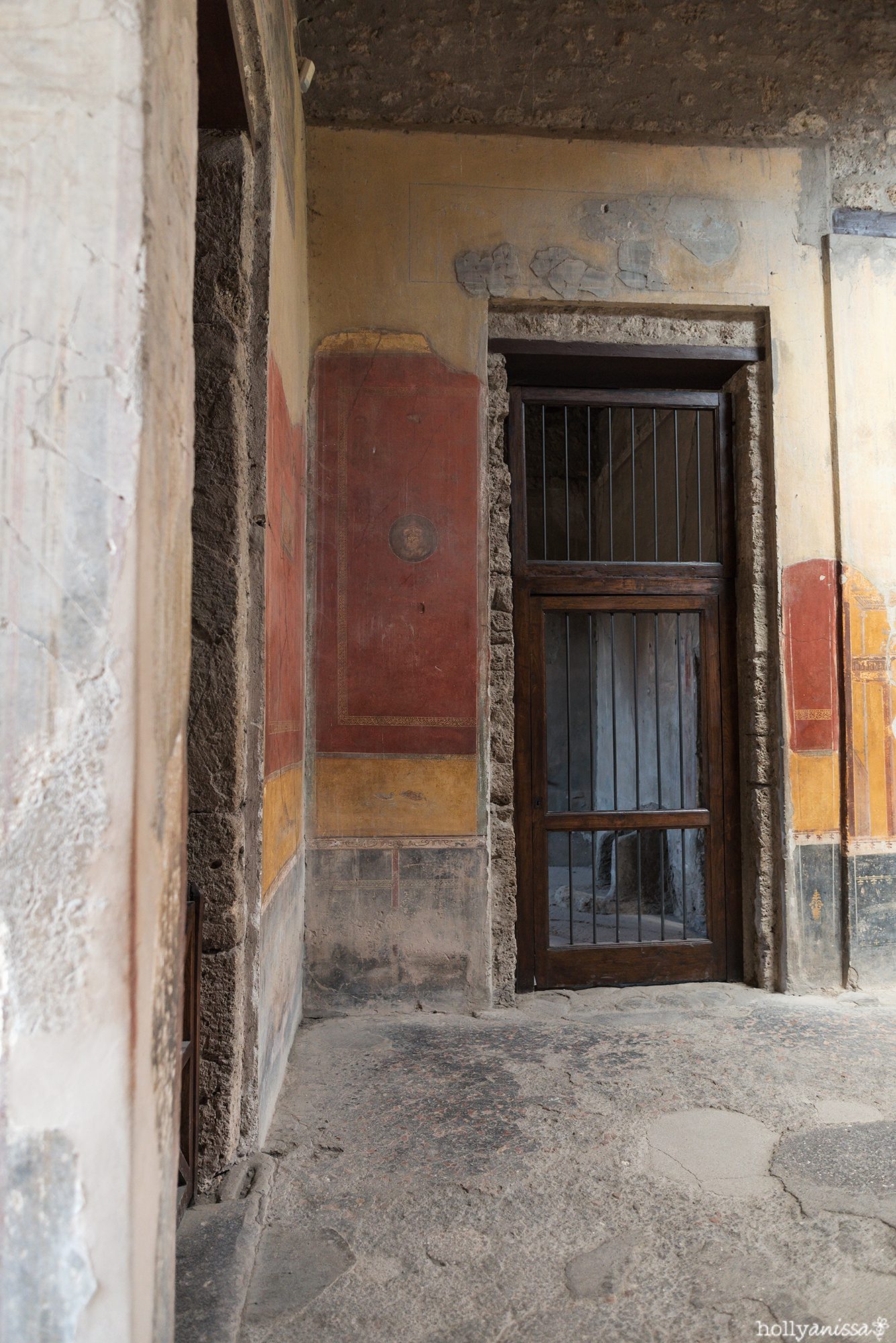
Nikon D750 | 20mm | f/2.2 | 1/320 | ISO 800
Ancient Art
Most of the homes and business had frescoes and mosaic art adorning the walls and floors. This wall depicts a couple, perhaps the owners. The art would include subjects such as mythology, erotica (more on this later!), architecture, trompe-l’oeil, religious practices, sports and family portraits. Tromp-l’oeil is a technique that tricks the eye with perspective, making things appear more three-dimensional. Lello said this is one of the first societies to employ such a sophisticated technique.
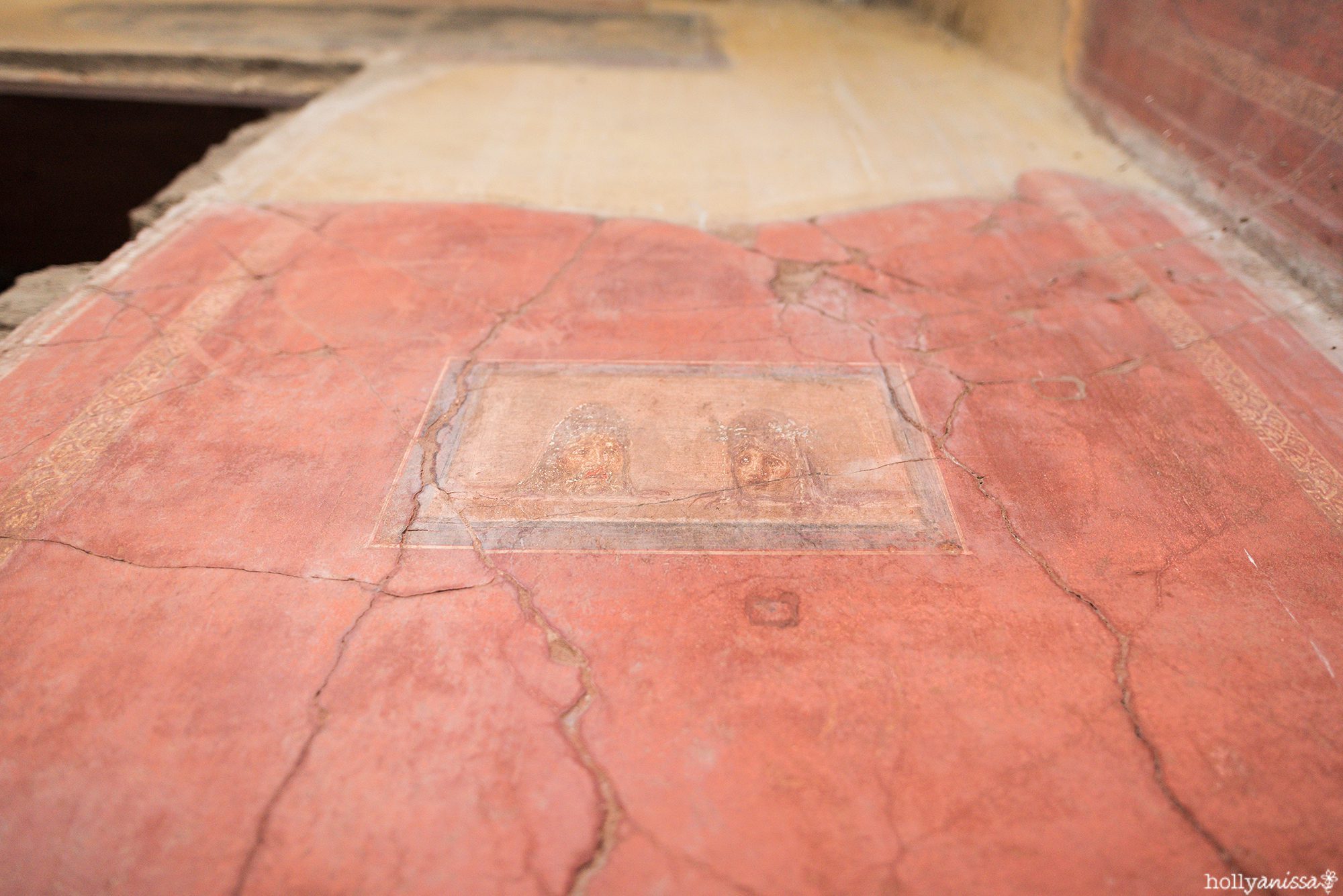
Nikon D750 | 20mm | f/1.8 | 1/320 | ISO 800
Upstairs
The Casa del Menandro had an upstairs also. This stairwell is located in the front right corner of the house. We weren’t allowed access on his day but sometimes people are allowed to visit the upstairs.
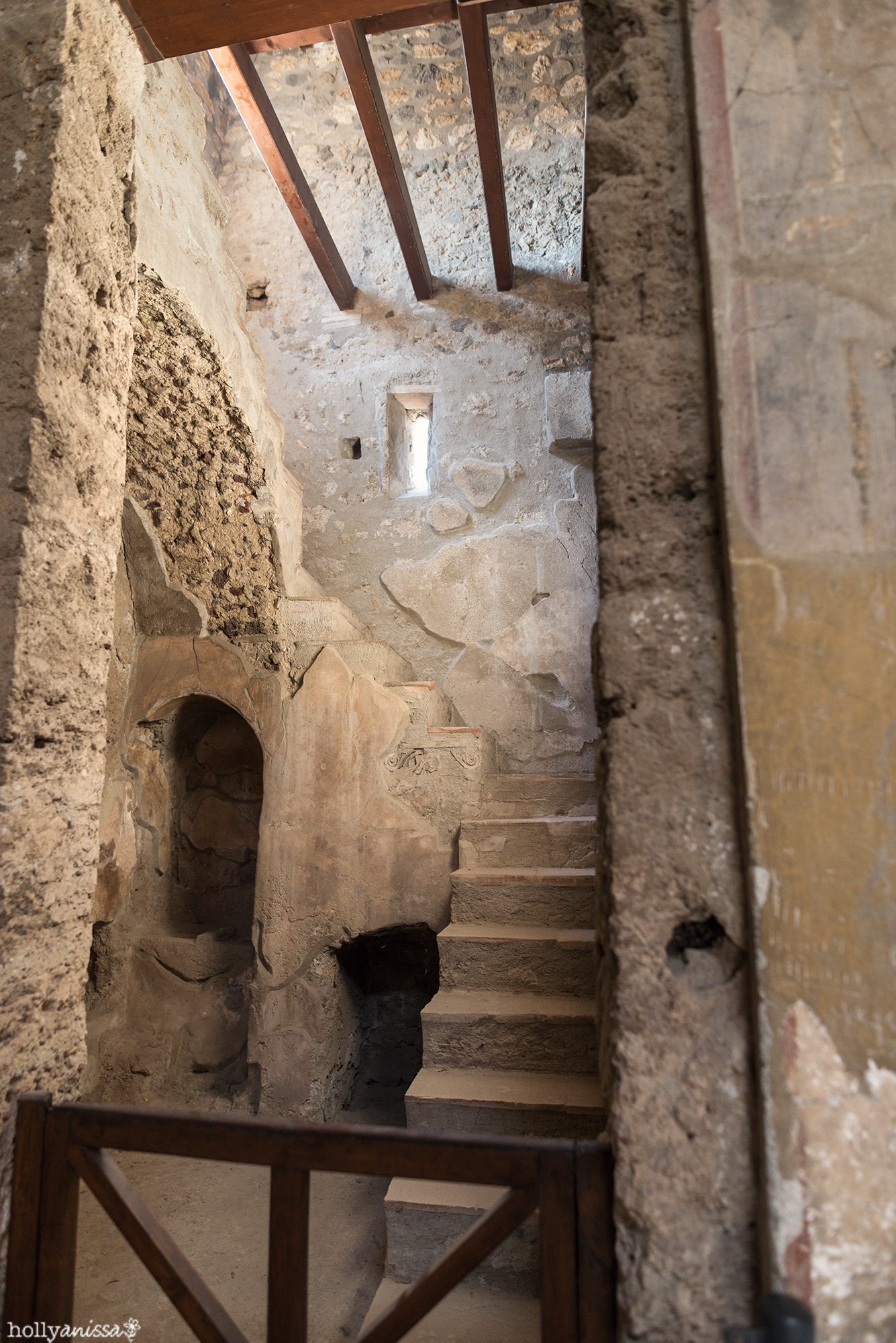
Nikon D750 | 20mm | f/2.2 | 1/250 | ISO 800
Curtis’s version.
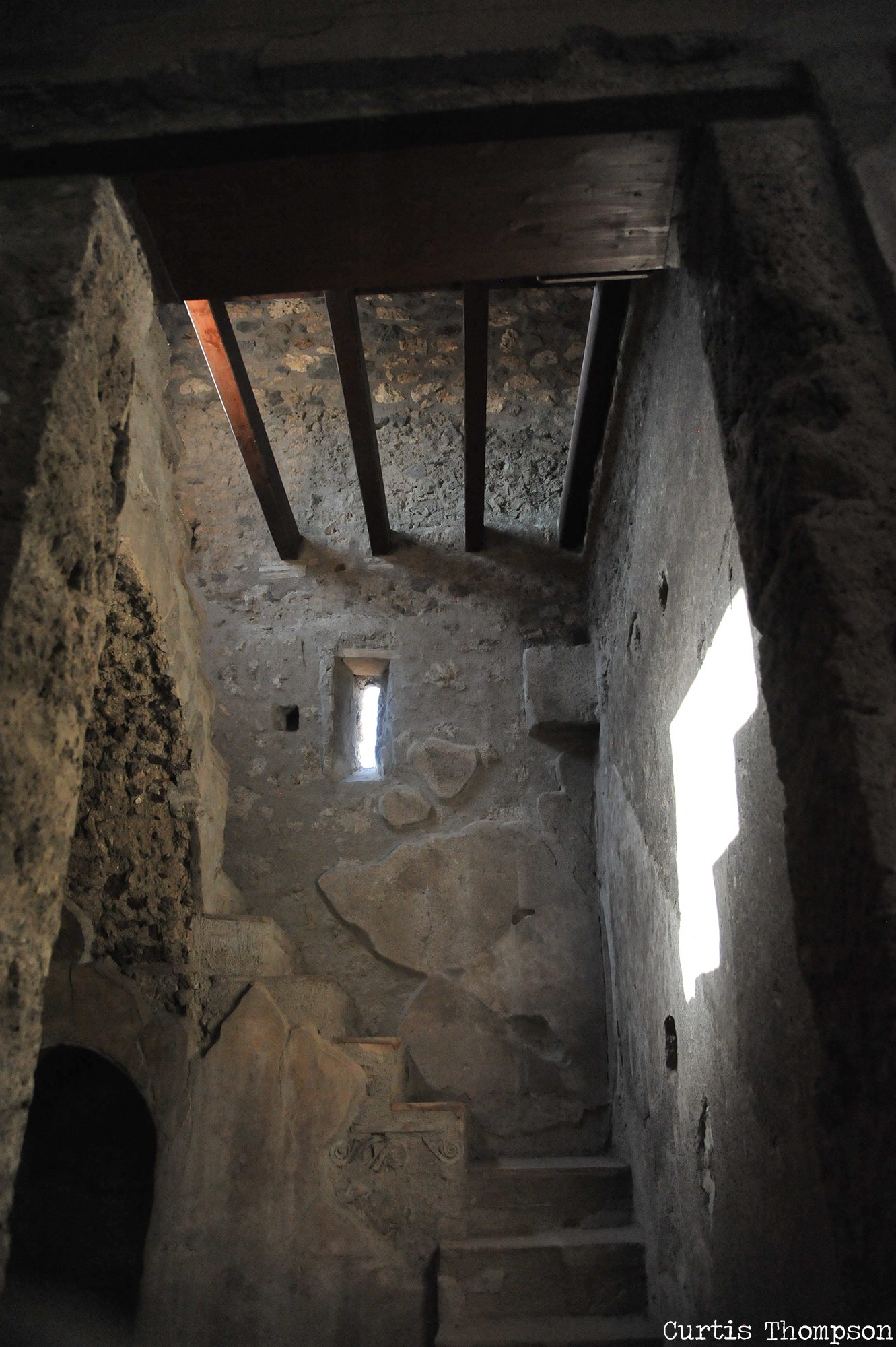
Nikon D700 | 24mm | f/4 | 1/1600 | ISO 4000
Dining Room
So apparently the dining room was a happening place. The room to the left is the gated kitchen, the large open room in the center is the dining room. This is all on the left side of the house after we entered. Raised beds with a slight elevation for the head were slightly above the table serving food. People would eat lying down, facing into the house. Then after they had eaten, people would get naughty!!! Couples did not sleep in the same room, so sex happened in the dining room. When guests were over, business and politics would be discussed in the dining room. Art adorns the walls.
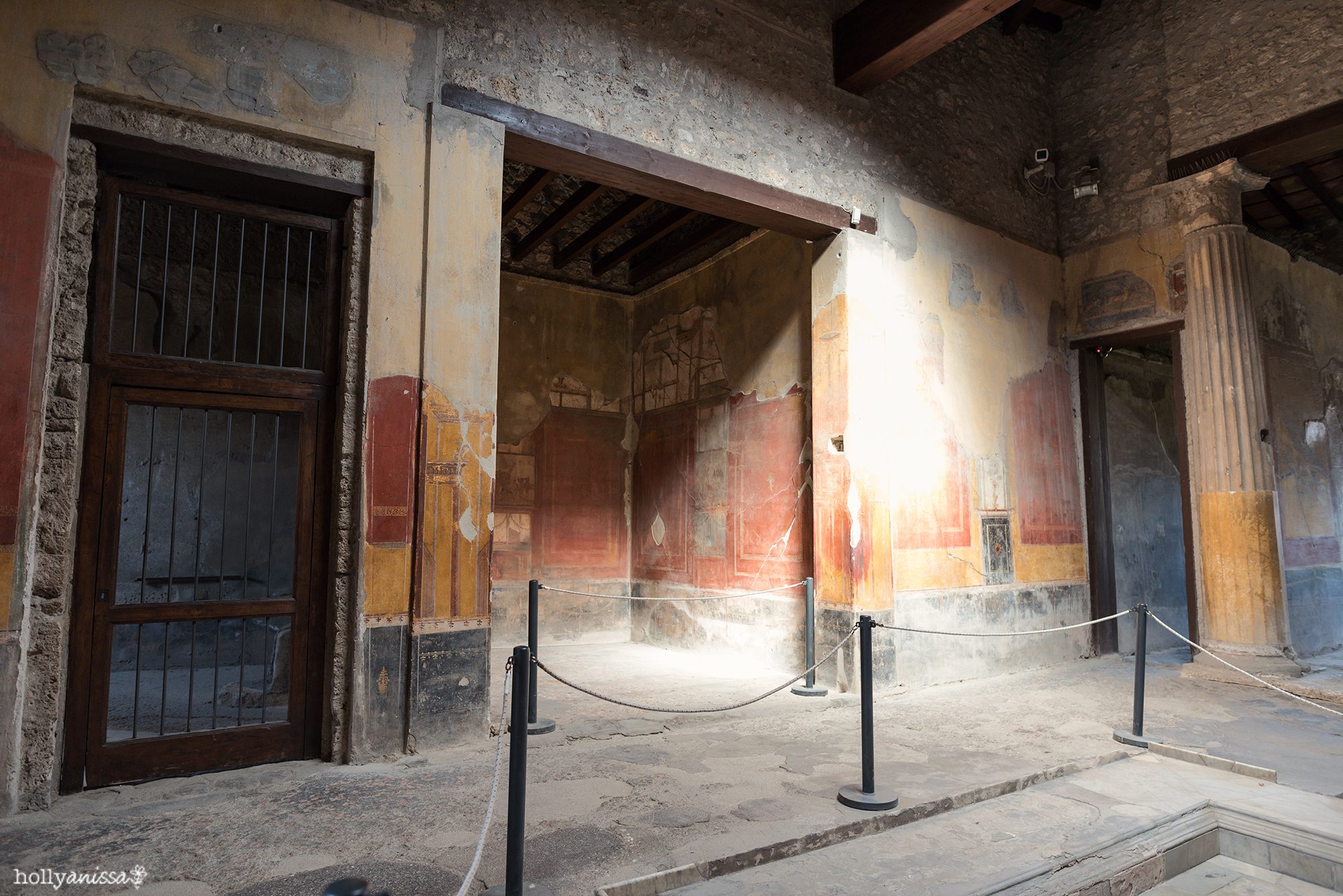
Nikon D750 | 20mm | f/2.8 | 1/250 | ISO 800
The Atrium and the Pool
Immediately upon entering the house, there is an open (as in open to the sky, no ceiling) atrium with a small pool at the center. As I’ve already described, there was a bathroom on the front left, the kitchen in the front left corner, and the dining room on the left wall. In the left rear corner were where the servants stayed. On the right front was an altar, then the stairwell in the front right corner, and on the right side, two bedrooms… one for the head female and the other for the head male. Upstairs is where the children slept. The center pool, called the impluvium, would catch rain water to provide water to the family. The open design would allow air flow. This was another of Professor Lello’s questions… which Curtis guessed wrong and got a nasally “Ehh!” buzzing sound. Too funny. He made us nervous to answer wrong! Just beyond the pool was the main reception or business room. Beyond that was an open courtyard with gardens or fountains, which could either grow food for the family or for the business. This courtyard was surrounded by rooms for guests, staff, and extended family.
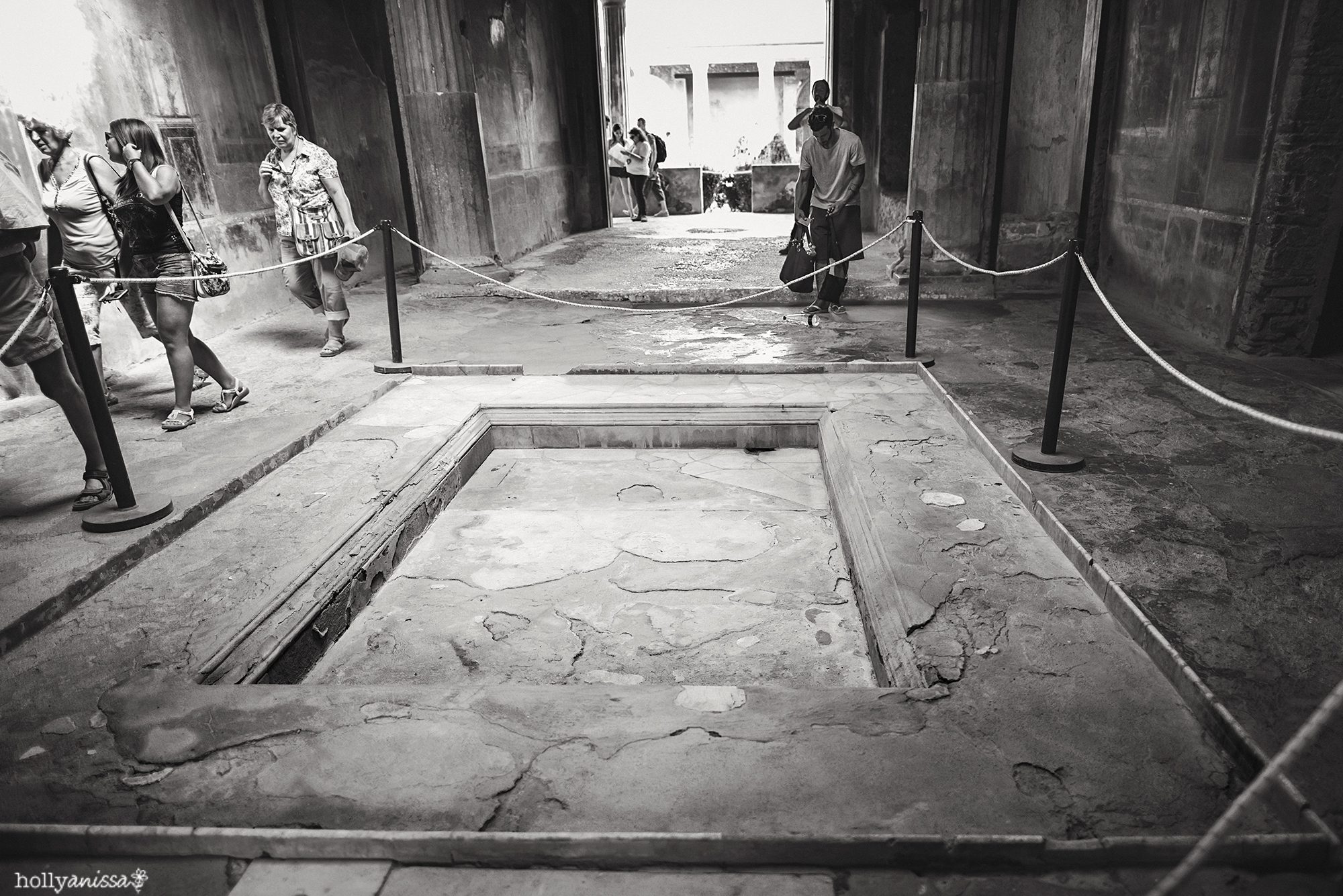
Nikon D750 | 20mm | f/1.6 | 1/250 | ISO 800
Lello and the Lion
Lello was quite proud and excited to show off the artwork on the walls of this home. Here you see a lion painted with a floral frame within a painted window frame. We next visited the main open courtyard and looked into a few of the rooms surrounding it. Lello yelled at some tourists taking a selfie… he said that it was disrespectful to take such a picture here. Yikes. Then he muttered about the barbarians. He said the day before a cruise ship had docked and thousands of tourists descended on Pompeii. He hates the big groups of tourists. He says they have no respect for this sacred place. I was surprised by how little it is guarded and protected. There are only simple ropes and gates, the artwork could easily be defaced or destroyed.
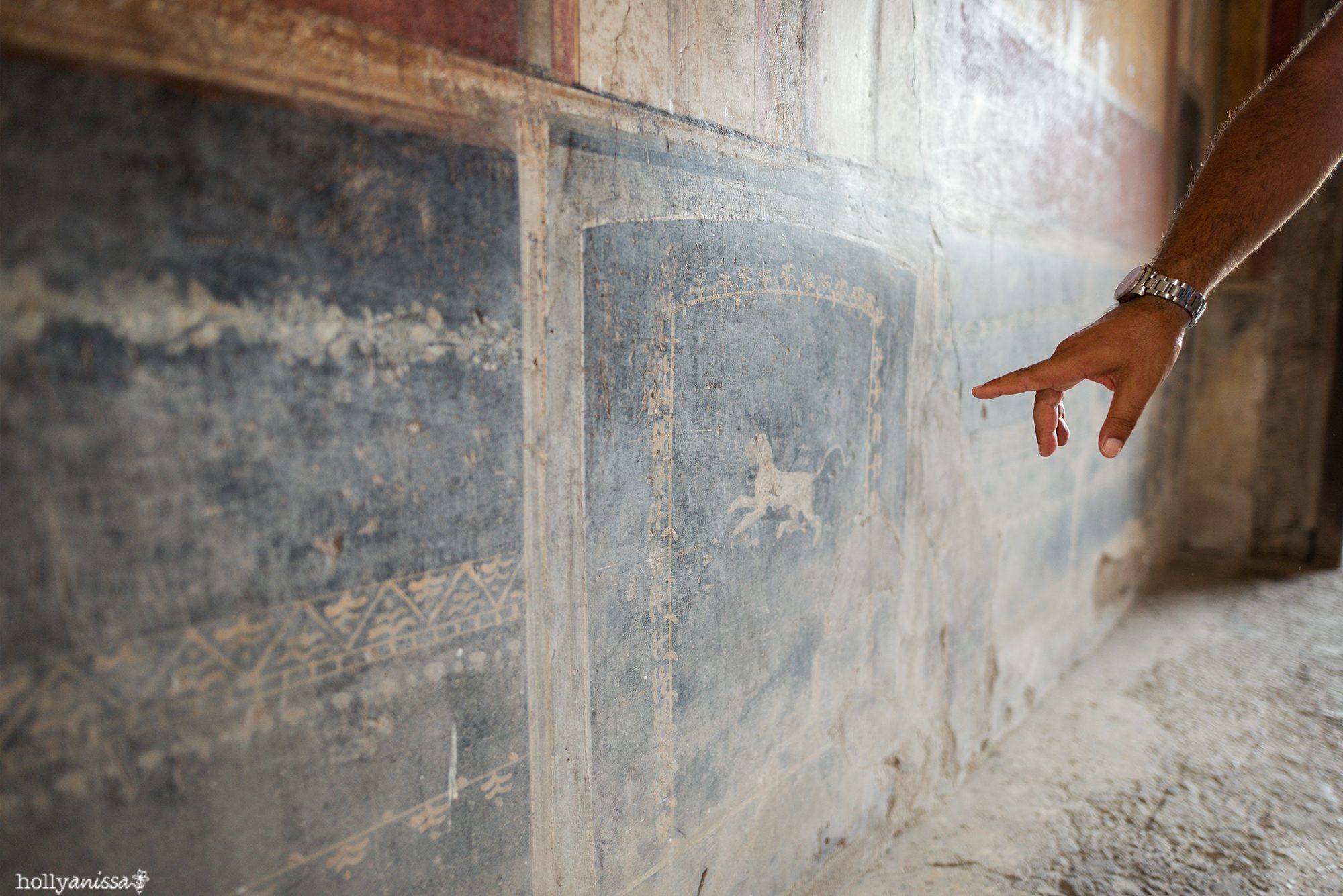
Nikon D750 | 20mm | f/1.6 | 1/250 | ISO 800
We were then given a bathroom break. We had to climb nearly three flights of stairs to get up to the bathrooms but this also gave us a good perspective. Not only did we get a great view (Curtis climbed a short wall to get this shot) but this was also the level at which Pompeii was originally buried.
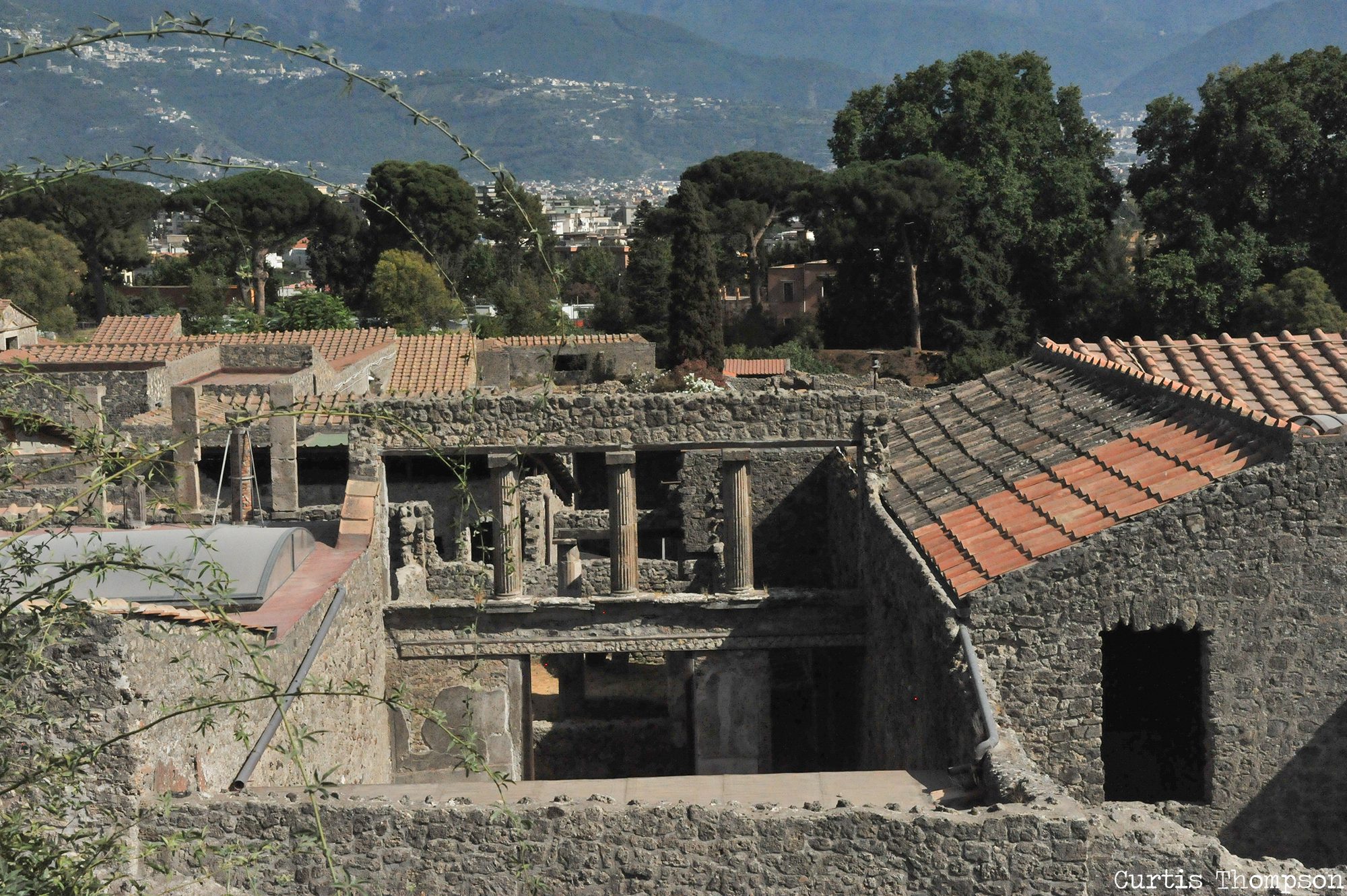
Nikon D700 | 58mm | f/18 | 1/8000 | ISO 4000
Up Equals Rich
Next we visited the rich side of town, which is on the upper end of the city (no waste for these people to deal with!). The homes and businesses were substantially larger. Lello equated this section with Rodeo Drive!
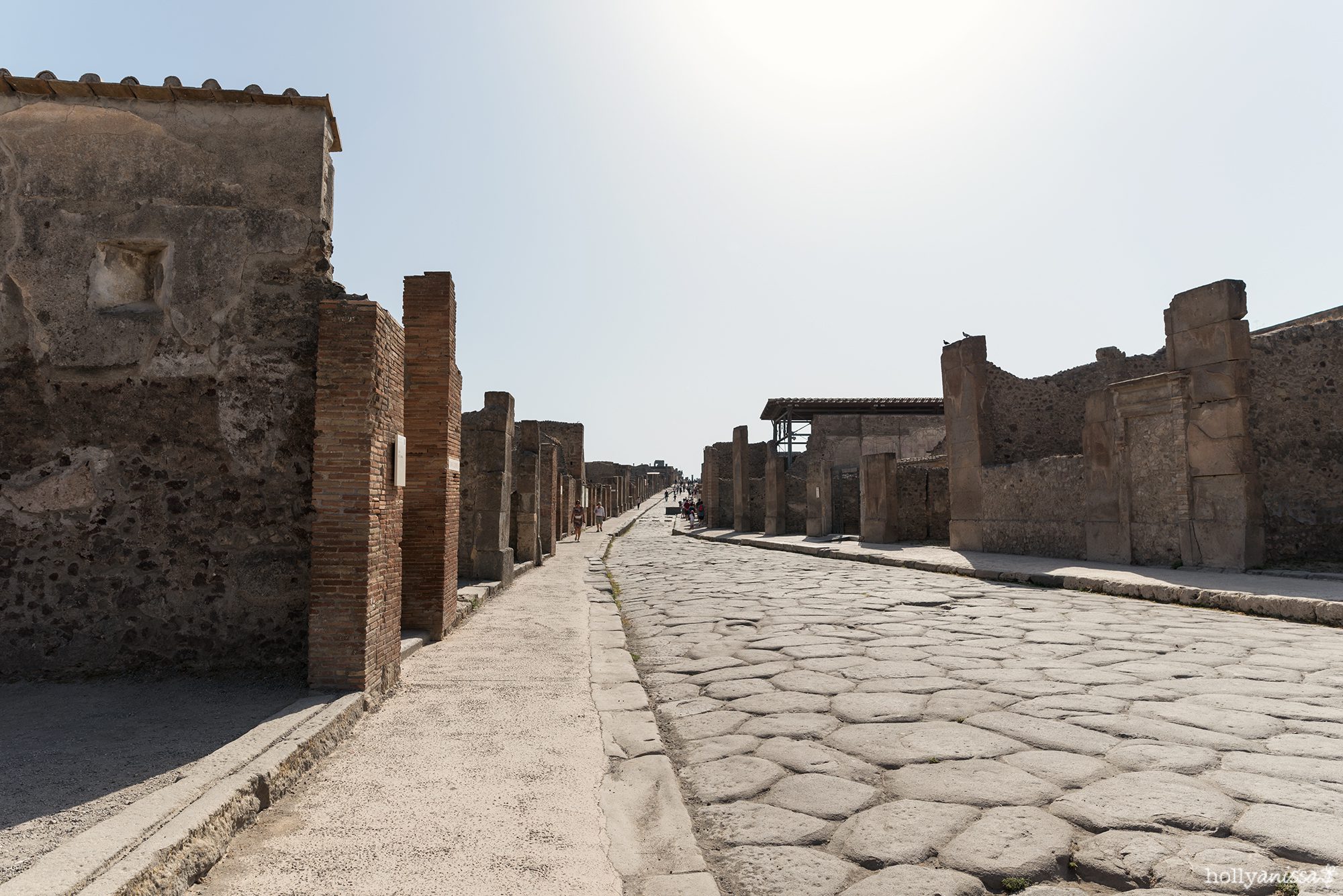
Nikon D750 | 20mm | f/6.3 | 1/500 | ISO 100
Love these shadows Curtis captured looking back down toward the poorer part of the city.

Nikon D700 | 24mm | f/18 | 1/8000 | ISO 4000
Terme Stabiane
This was the entrance to the Stabian Baths and Gymnasium, the public bath house. I got a cute shot of Curtis and Lello at the entrance (and a random tourist).
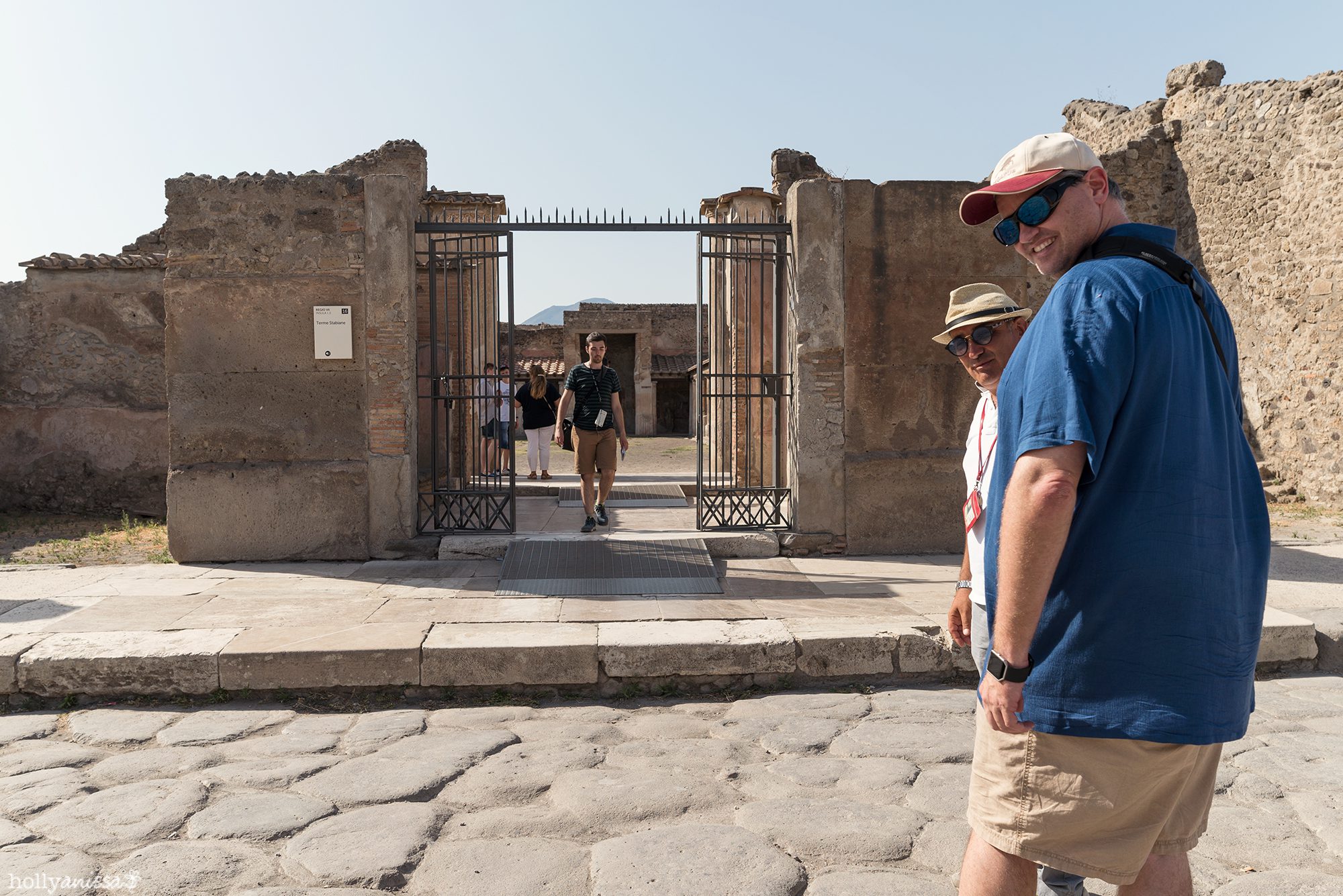
Nikon D750 | 20mm | f/6.3 | 1/500 | ISO 100
Gymnasium
This large open area was called the Gymnasium. The baths were to the right. Lello said that this open space was filled with weight and workout equipment! Men would also stage fights here.
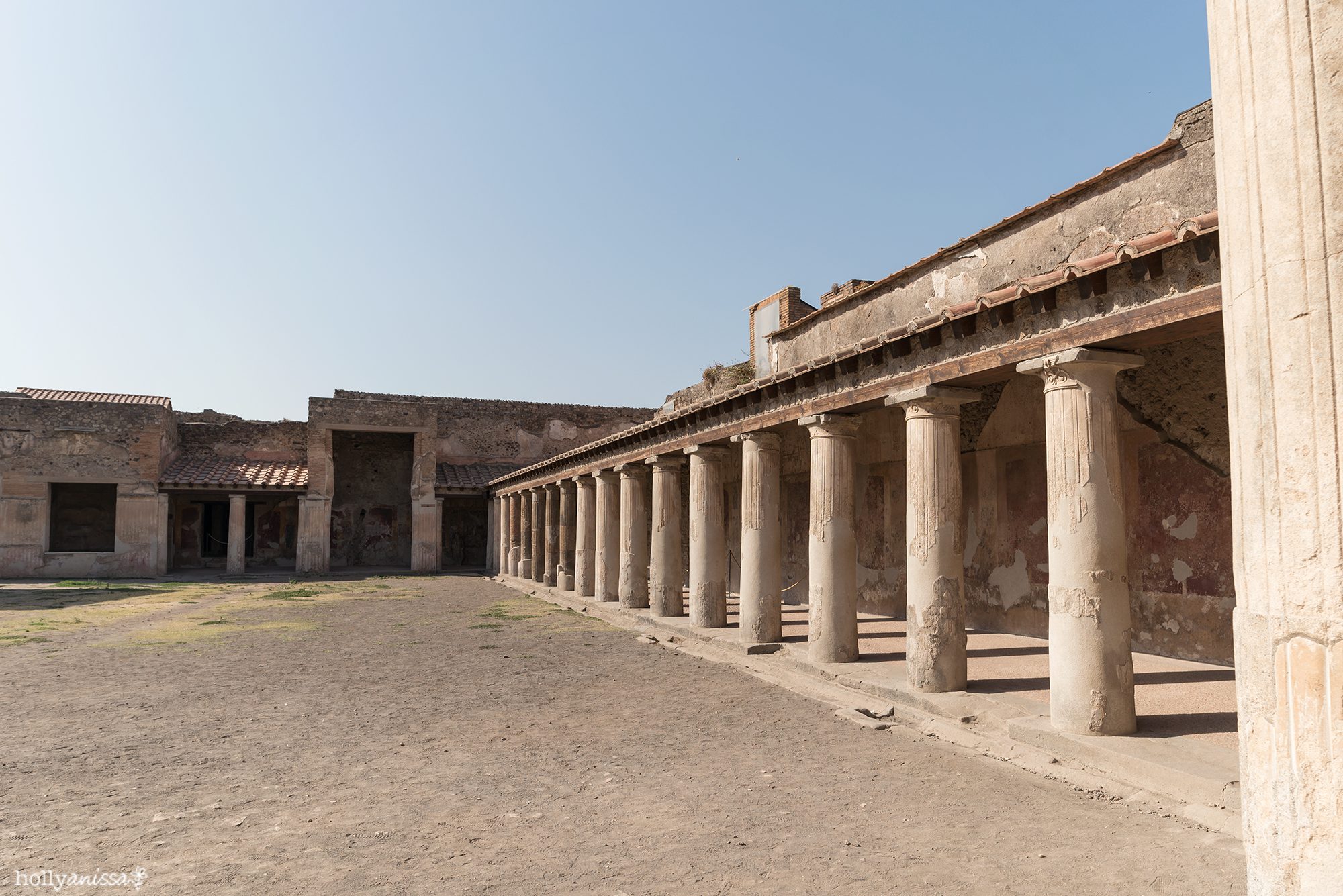
Nikon D750 | 20mm | f/6.3 | 1/500 | ISO 100
Curtis got this great shot of the column shadows that surround the open gymnasium courtyard.

Nikon D700 | 35mm | f/22 | 1/800 | ISO 4000
Bath Ceiling
Walking into the baths on the right side of the courtyard, we enter the baths. The spa was split into a men’s side and a women’s side, and we were visiting the men’s side. There was a large barrel vaulted ceiling at the entrance. The details were beautiful and you can tell it was geared to a higher end clientele.

Nikon D750 | 20mm | f/1.6 | 1/160 | ISO 800
Curtis’s version. He got a much better shot than me showing the curve of the ceiling.
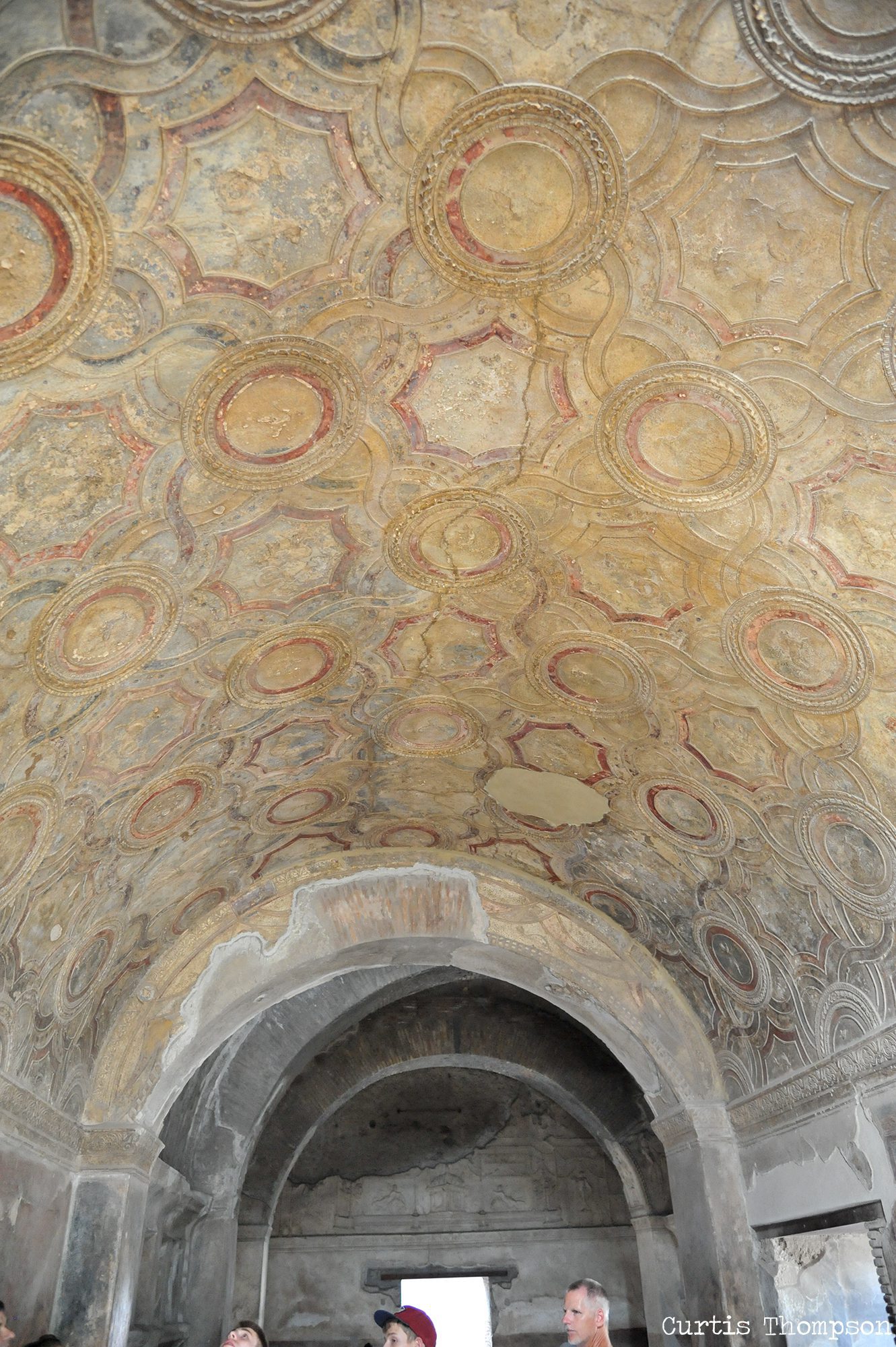
Nikon D700 | 24mm | f/4 | 1/100 | ISO 4000
A close-up of one of the carvings in the ceiling. Awesome details, baby!
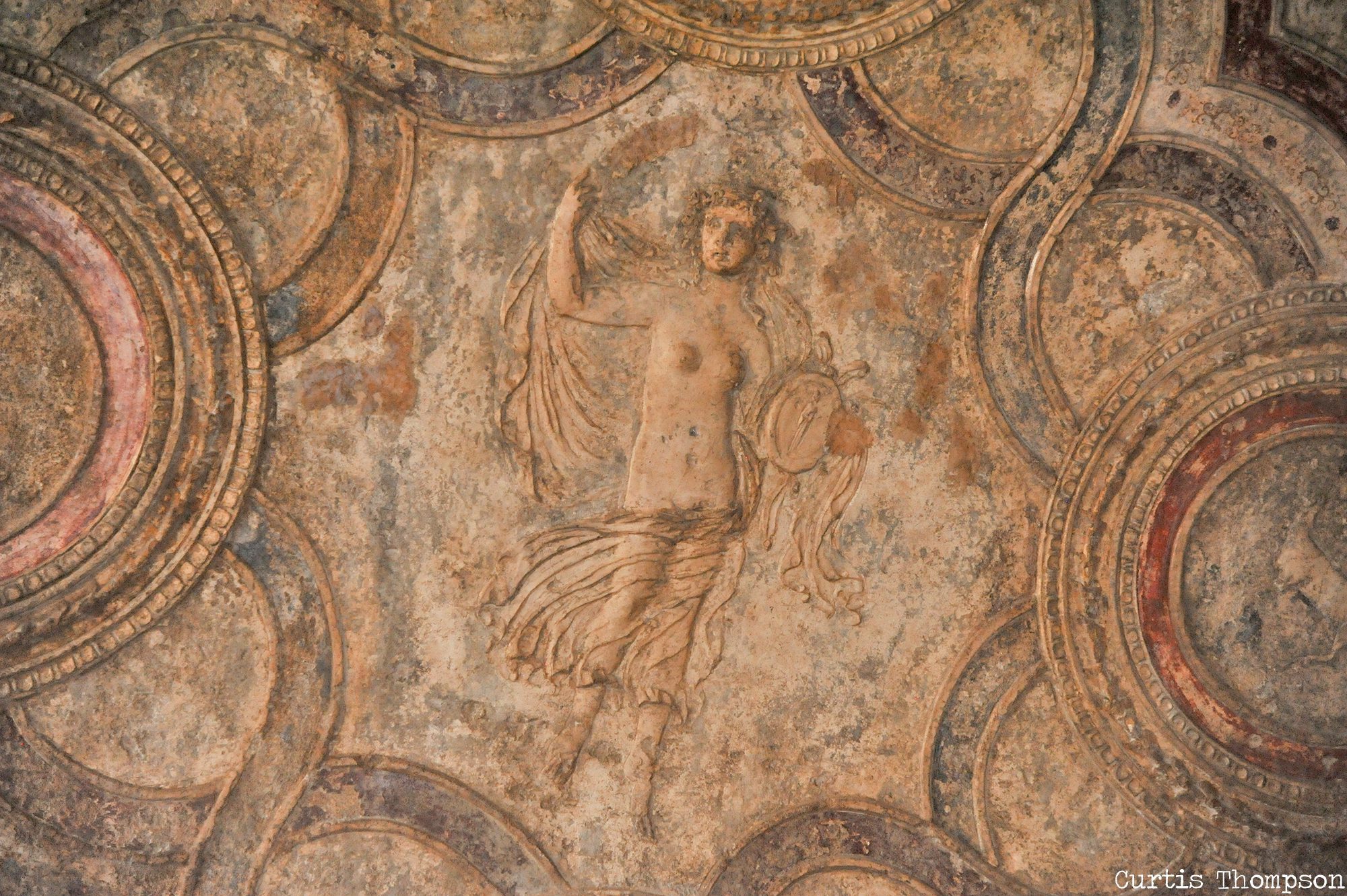
Nikon D700 | 78mm | f/4 | 1/200 | ISO 4000
Frigidarium
After entering the building, there is a large locker-room, where men could store their belongings and undress. Male-on-male, male-on-female, and even threesome erotica adorned the walls above the benches and cubbies since sex was part of the culture and business. Just inside the entrance of the Stabian Baths on the left is this large cold pool called the Frigidarium. People would finish their time at the spa by a quick dip into the cold pool to rinse off. It’s circular in design and reminds me of a large hot tub.
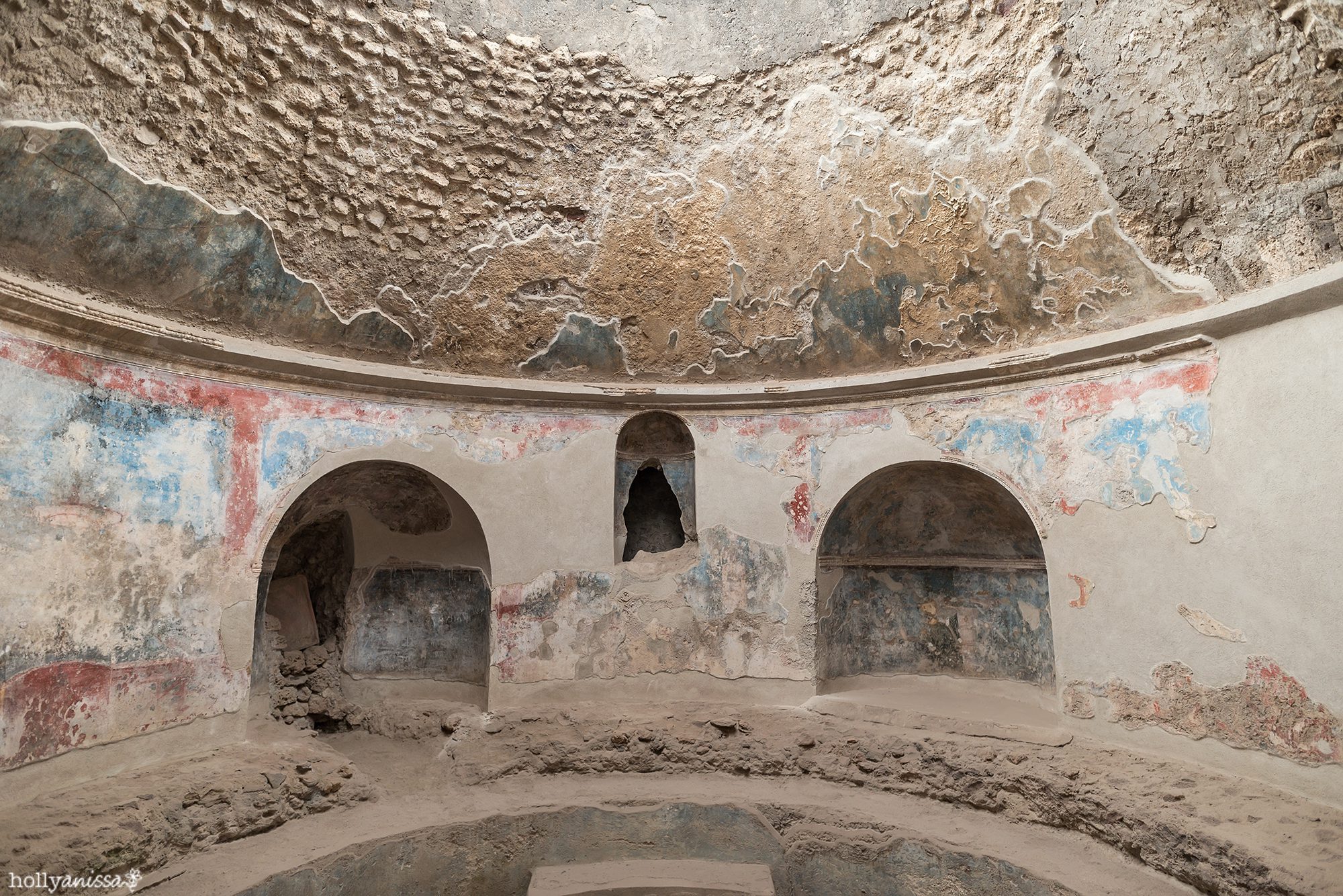
Nikon D750 | 20mm | f/2.5 | 1/250 | ISO 800
Steam Room
The steam room is quite a clever engineering design. The floor was raised and the walls had an empty chamber, both designs allowing the furnaces to heat the air and water to create steam.
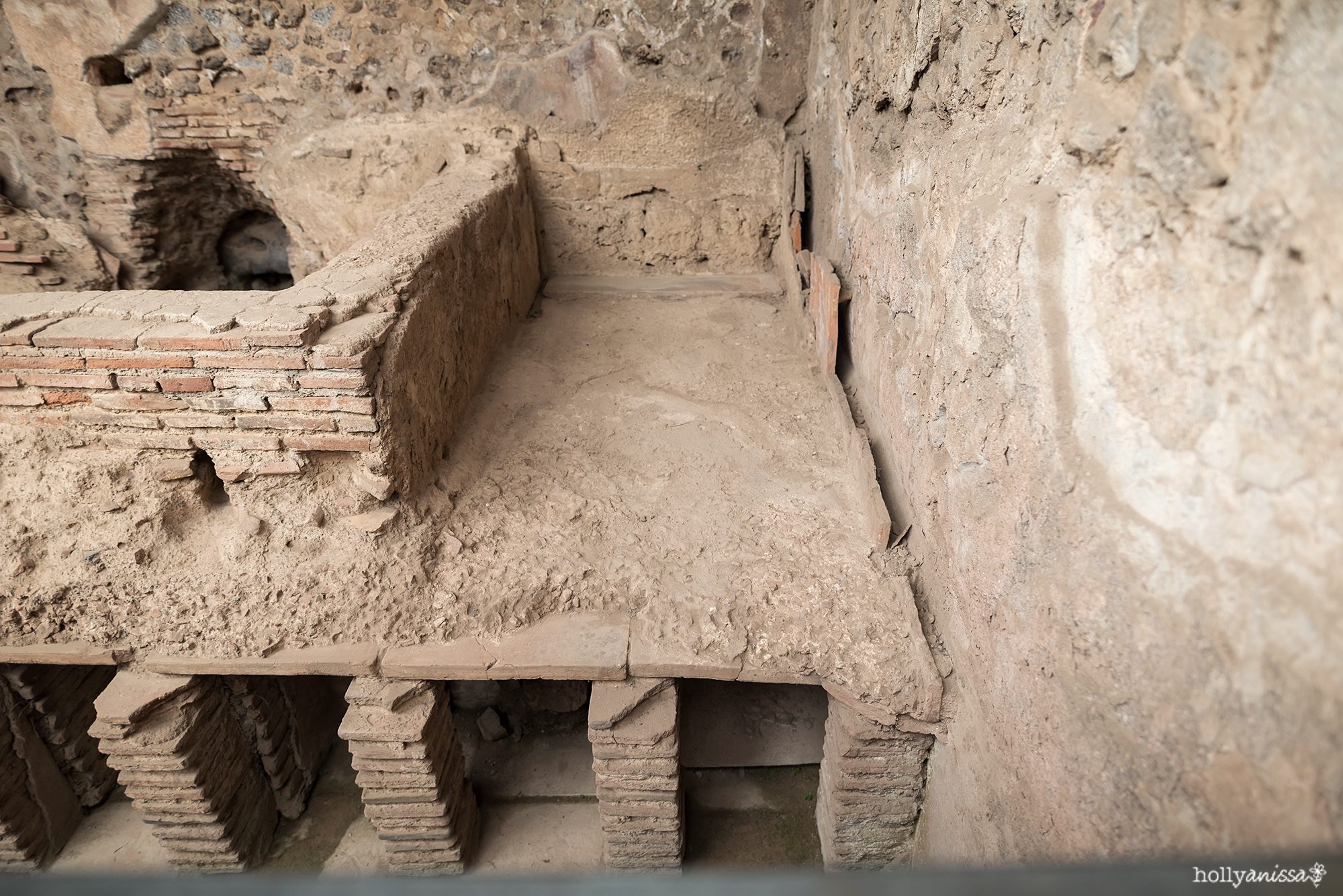
Nikon D750 | 20mm | f/2 | 1/250 | ISO 200
Destrictarium
Across the open courtyard on the left side is this building called the destrictarium. It is thought that men would change into workout clothes, apply oil in this building before engaging in exercise, then return to scrape the oil off and plunge into the large pool behind the building. The outside of the building is covered with artwork of mythological gods.
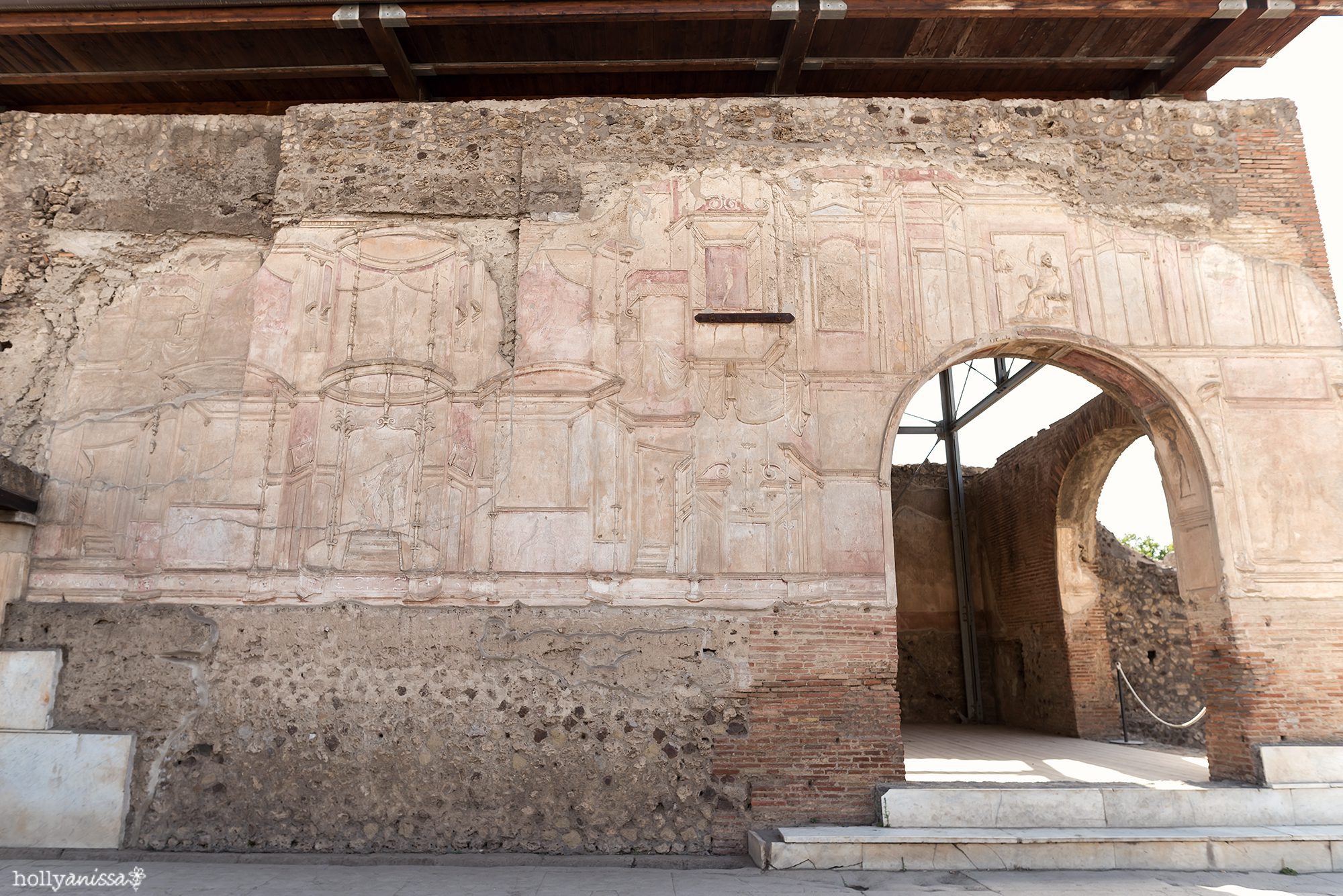
Nikon D750 | 20mm | f/4 | 1/320 | ISO 160
Frozen in Time
Unfortunately all of the recovered relics and bodies were not at Pompeii… they were actually in an archeological museum in Naples. However, they did have one preserved body on display inside the destrictarium. I learned several very interesting things… 1) This was not an actual body. When archeologists began excavation, they discovered empty chambers that once held bodies. They filled these empty spaces with plaster and thus were able to recreate positions of people when they died. 2) This was a woman who was pregnant. You can see her little belly bump. She wasn’t even 5′ tall. 3) She most likely died not from the volcanic ash but from asphyxiation from the gas released during the eruption. The gas is what killed most people well before the ash started covering the city. You can tell by how her arms are covering her face.
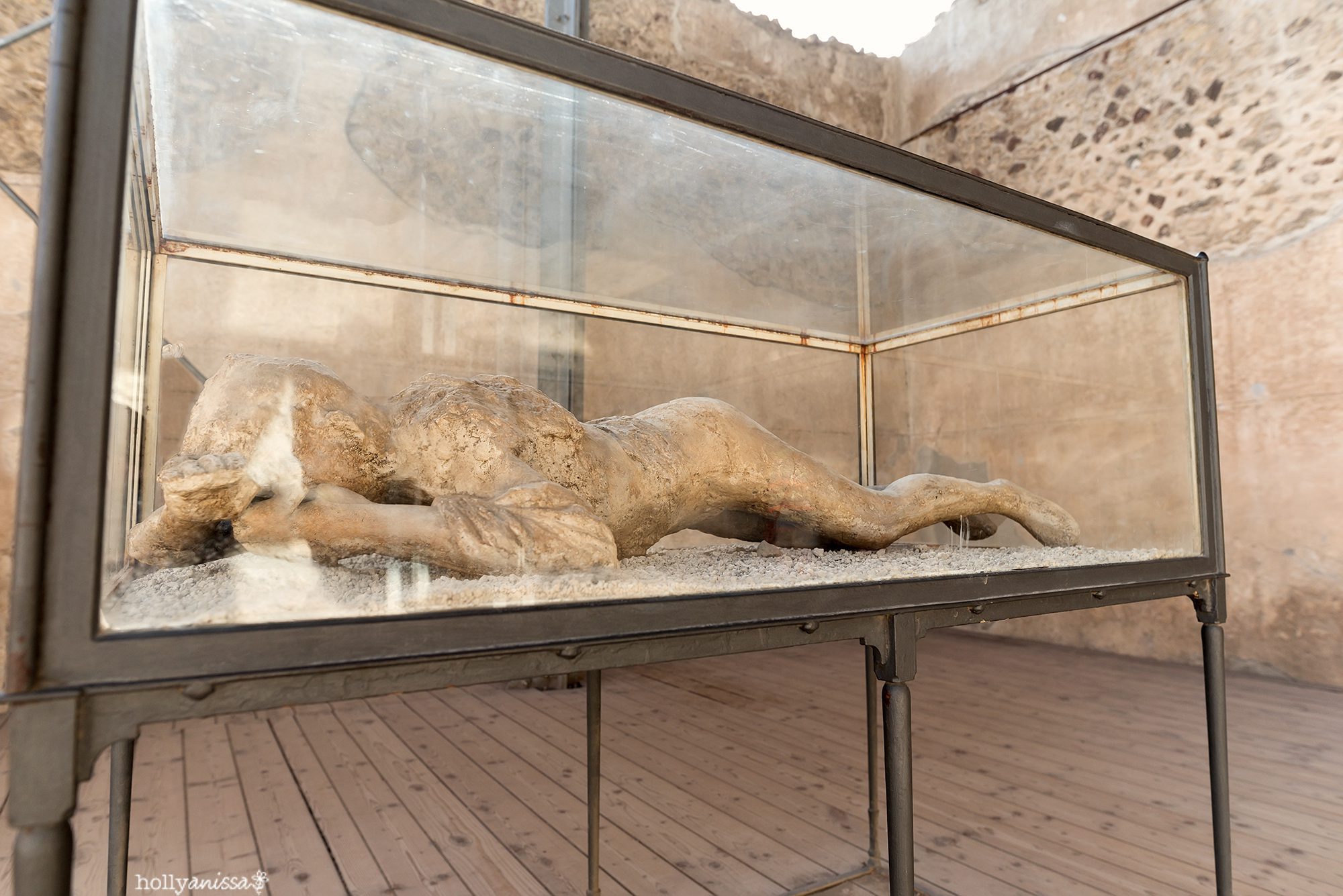
Nikon D750 | 20mm | f/4 | 1/320 | ISO 500
Ancient Erotica
Next we visited a brothel, one of several located throughout the Pompeii. Erotica adorns the walls. The art wasn’t used just to get clients in the mood… many men visiting the brothel would be from foreign lands and would not speak the language. This art also served as a menu of sorts. They could simply point at the image they wanted (two women, fellatio, various threesome configurations, etc.) and be serviced accordingly. All throughout the city, Priapus, the god of sex and fertility, is seen in carvings and in fresco form with an oversized erection. Lello indicated that it served as a marker to find the brothels as well as a sign of good fortune.
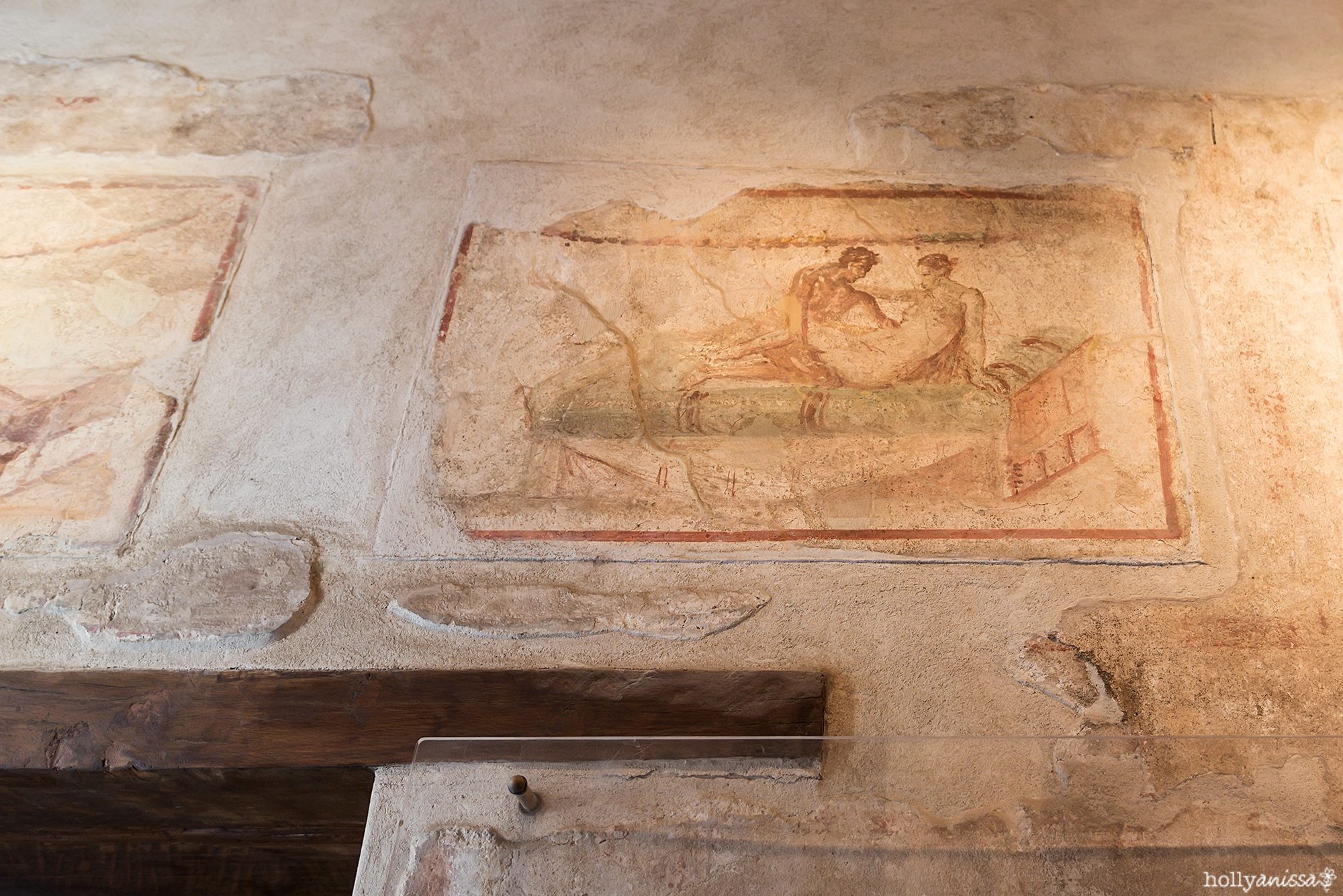
Nikon D750 | 20mm | f/2 | 1/160 | ISO 800
Brothel Bed
The brothel beds were small and made of stone. Wow, how uncomfortable. Lello asked, “Why do you think the beds were made of stone?” Curtis got this one right. So the clients would finish quickly because they were uncomfortable. They could move more clients in and out more rapidly and thus make more money. The prostitutes had a ranking system of marks on the doorway, which would increase her fee and popularity.
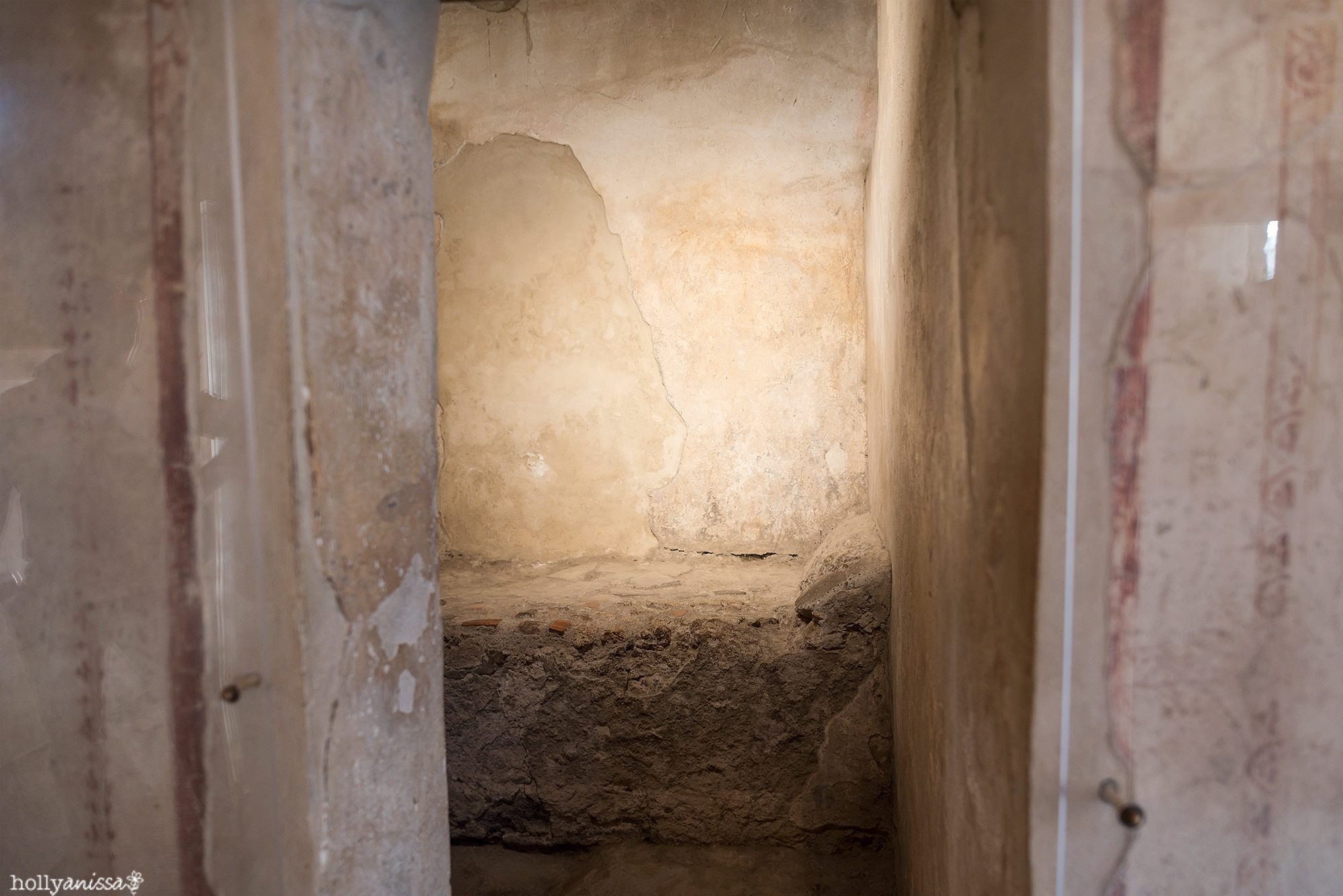
Nikon D750 | 20mm | f/2 | 1/160 | ISO 800
Are You Ready?
Here Lello is showing us one of the many public water fountains located throughout the city. Pompeii had an intricate aqueduct system which brought water into the city. Merchants and tourists alike could fill water jugs, wash their faces, and get a drink of water from the fountains. For the 20th time, Lello asks, “Now are you ready to see something even better? Let’s go!”
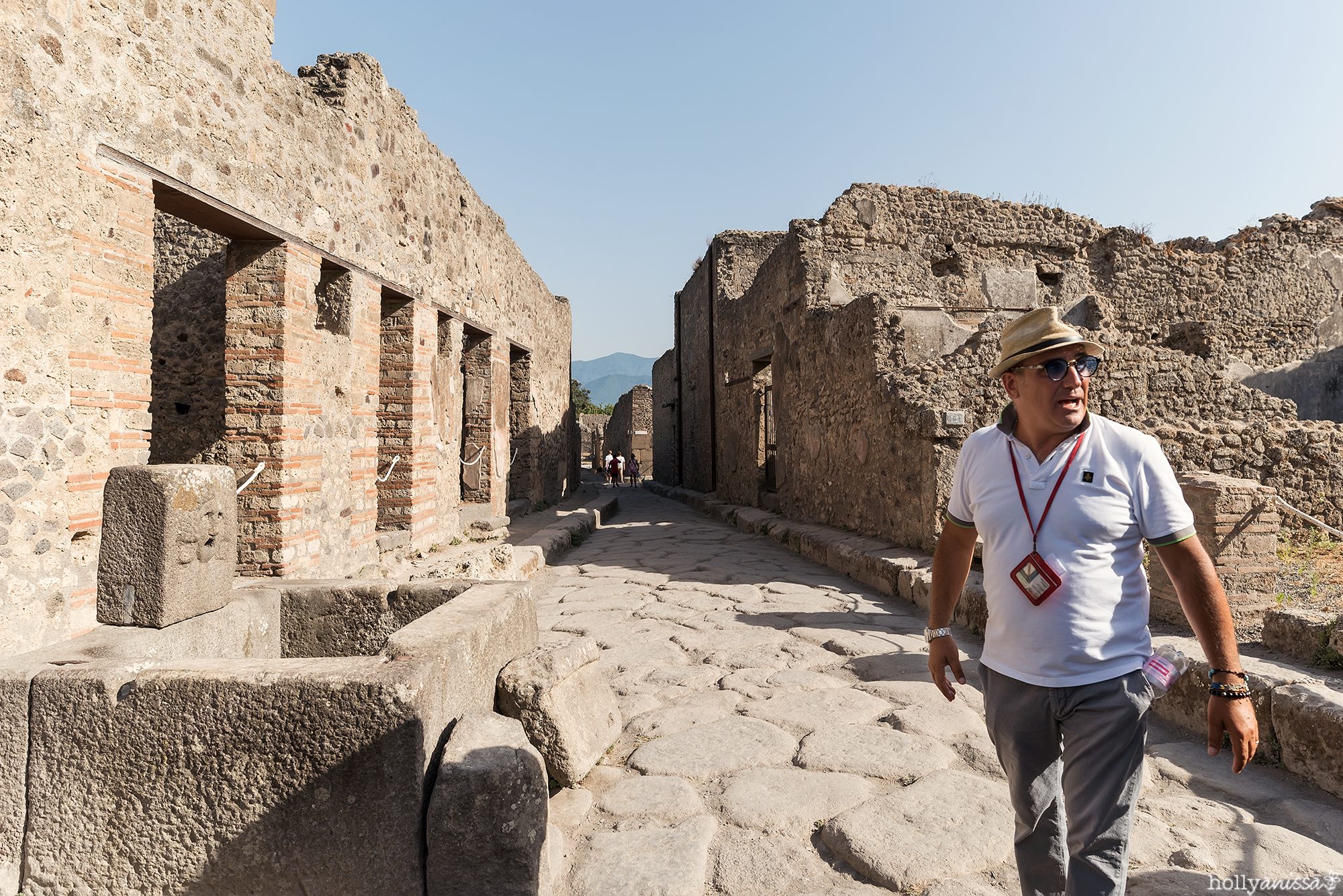
Nikon D750 | 20mm | f/5.6 | 1/400 | ISO 100
Rich Man’s Entry
We are almost at the end of the richest street in Pompeii and we come to a very large house of one of the wealthiest inhabitants. Look at the mosaic tile in the entrance! Much fancier than the other homes we’ve seen so far.
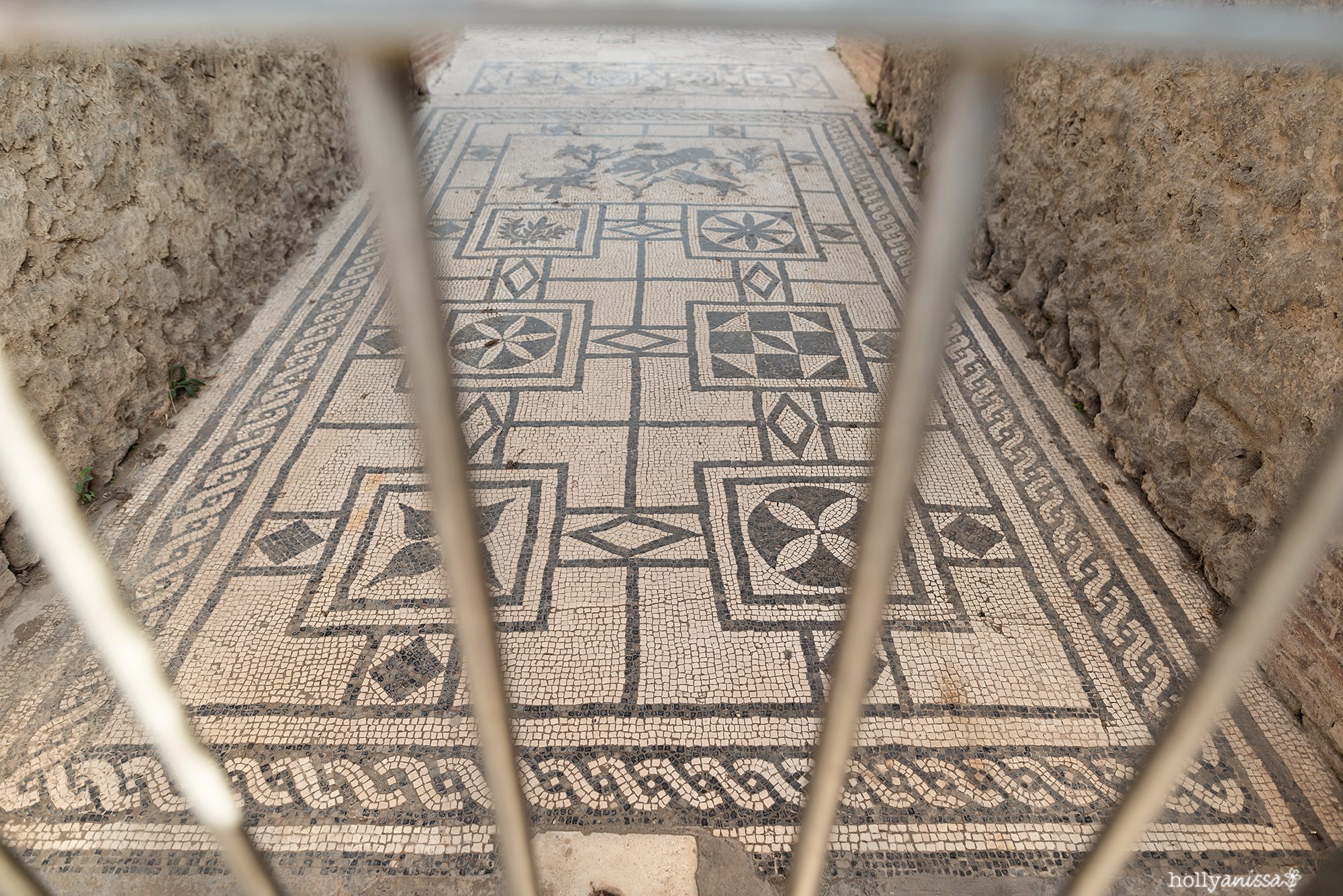
Nikon D750 | 20mm | f/2.8 | 1/160 | ISO 100
Rich Man’s Courtyard
Looking inside, you can see that the atrium, the impluvium, and the courtyard are also much larger than the other house we toured. The importance and influence this family must’ve had then, wow.
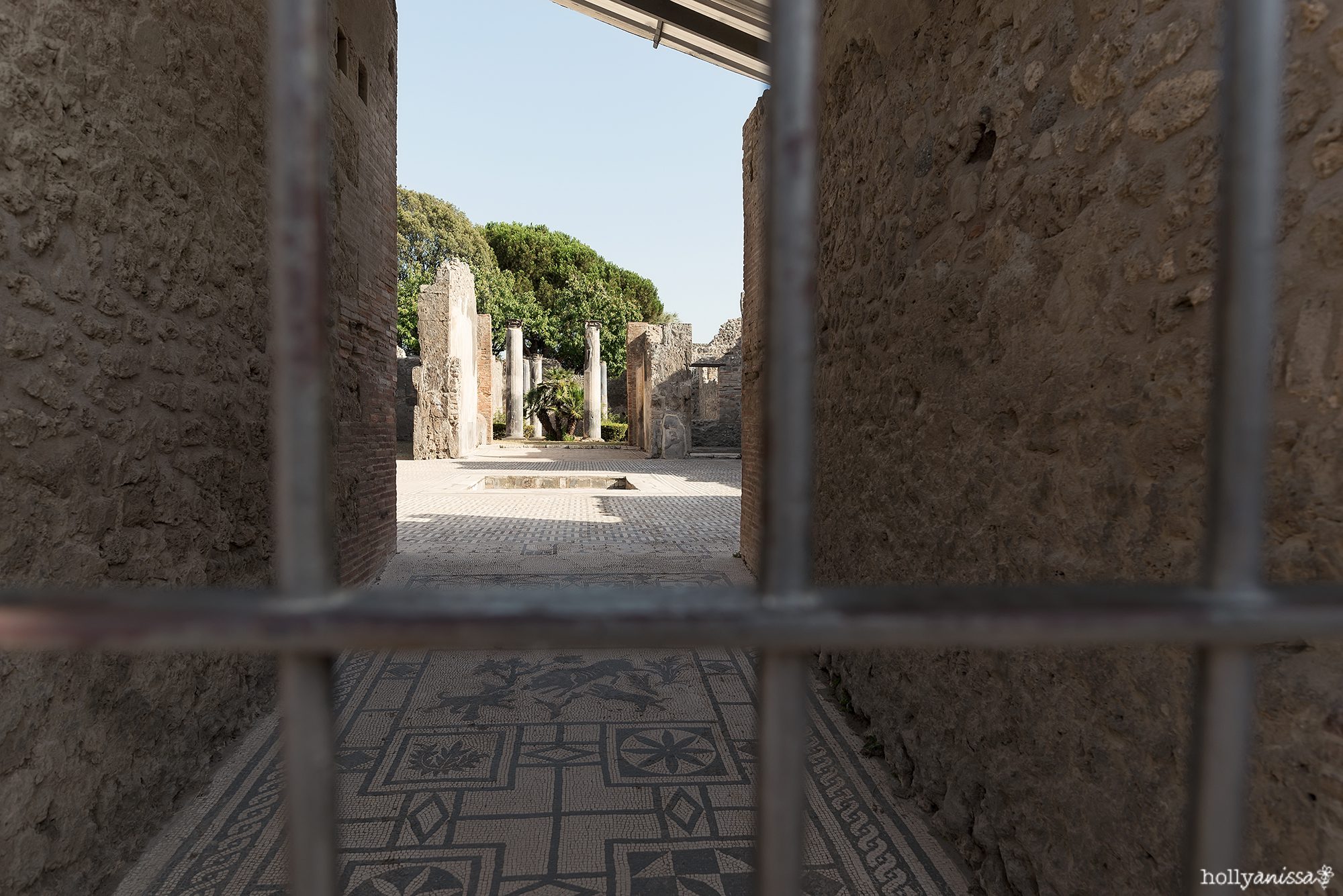
Nikon D750 | 20mm | f/5 | 1/320 | ISO 100
Civil Forum
In between “Rodeo Drive” and the port was the civil forum, a large area which housed the religious and civic center of Pompeii. This was also a thriving marketplace. Many important buildings surround the forum including the basilica, many temples, and municipal offices.
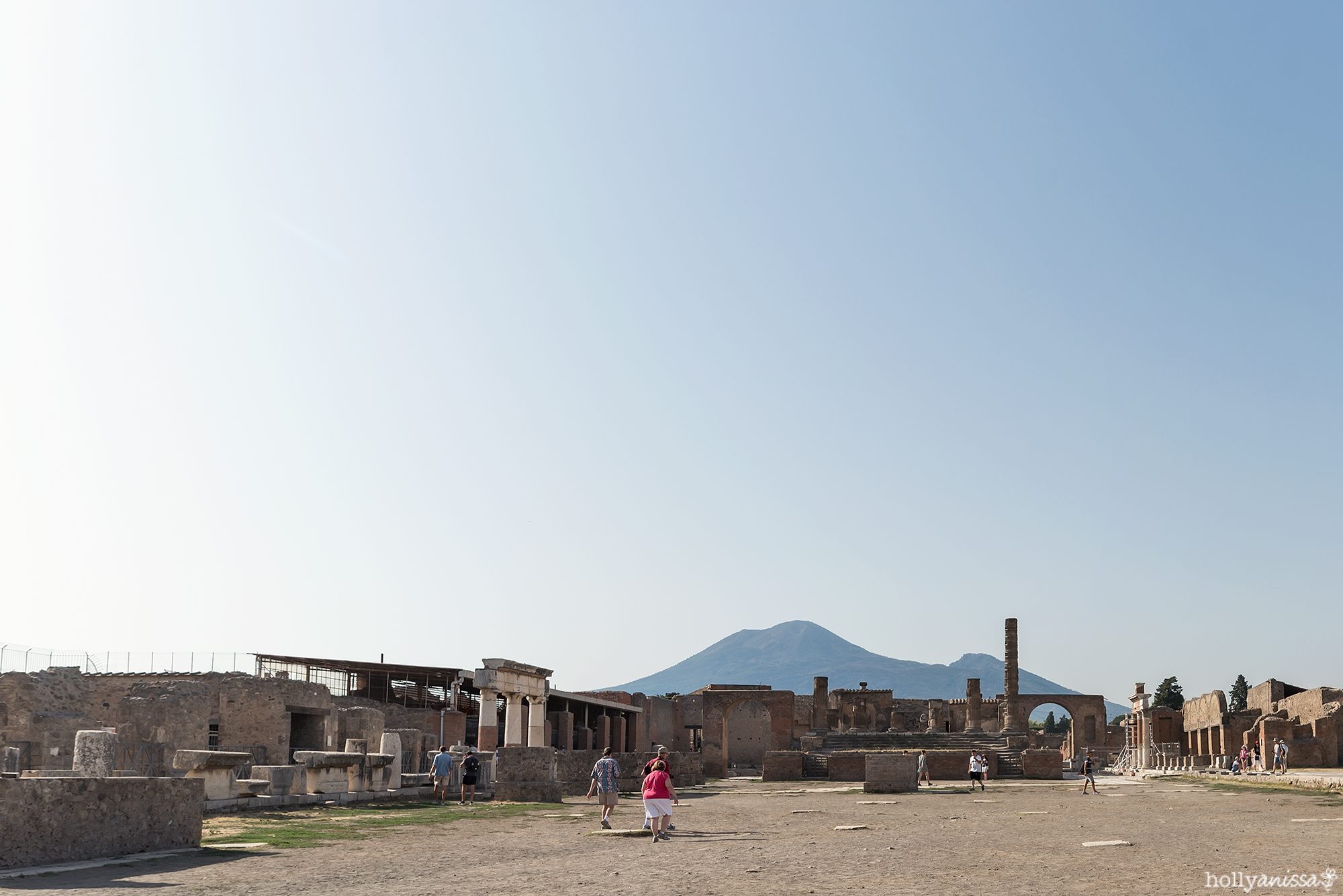
Nikon D750 | 20mm | f/7.1 | 1/320 | ISO 100
The Columns Remain
Surrounding the Forum was a two-story row of columns. Most of the statues were destroyed in an earthquake that happened 17 years before the eruption. Here you can see some goofy tourist pretending to hold up the columns.
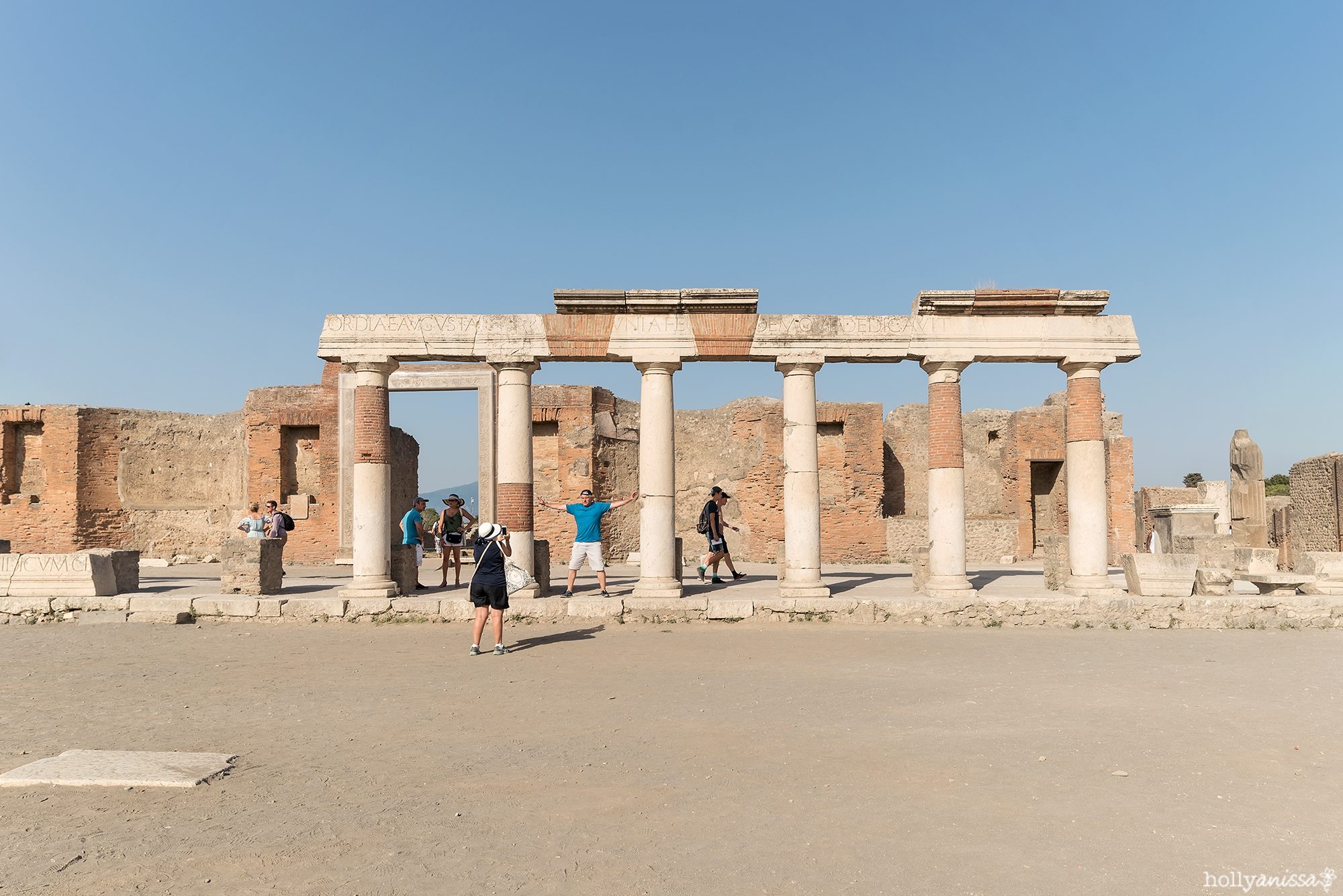
Nikon D750 | 20mm | f/7.1 | 1/320 | ISO 100
Tourist Pose
Lello offered to take a tourist picture of us together in front of the columns. We happily accepted. It was so bright! I was very happy with my new hat and wore it nearly every day the rest of the trip.

iPhone 6S+ | 4.2mm | f/2.2 | 1/2000 | ISO 25
Basilica
One of the last buildings we toured was the basilica. It was one of the most important civil buildings in Pompeii. This is where justice was served and acted as a court system. Commercial contracts and other financial deals were also done here.
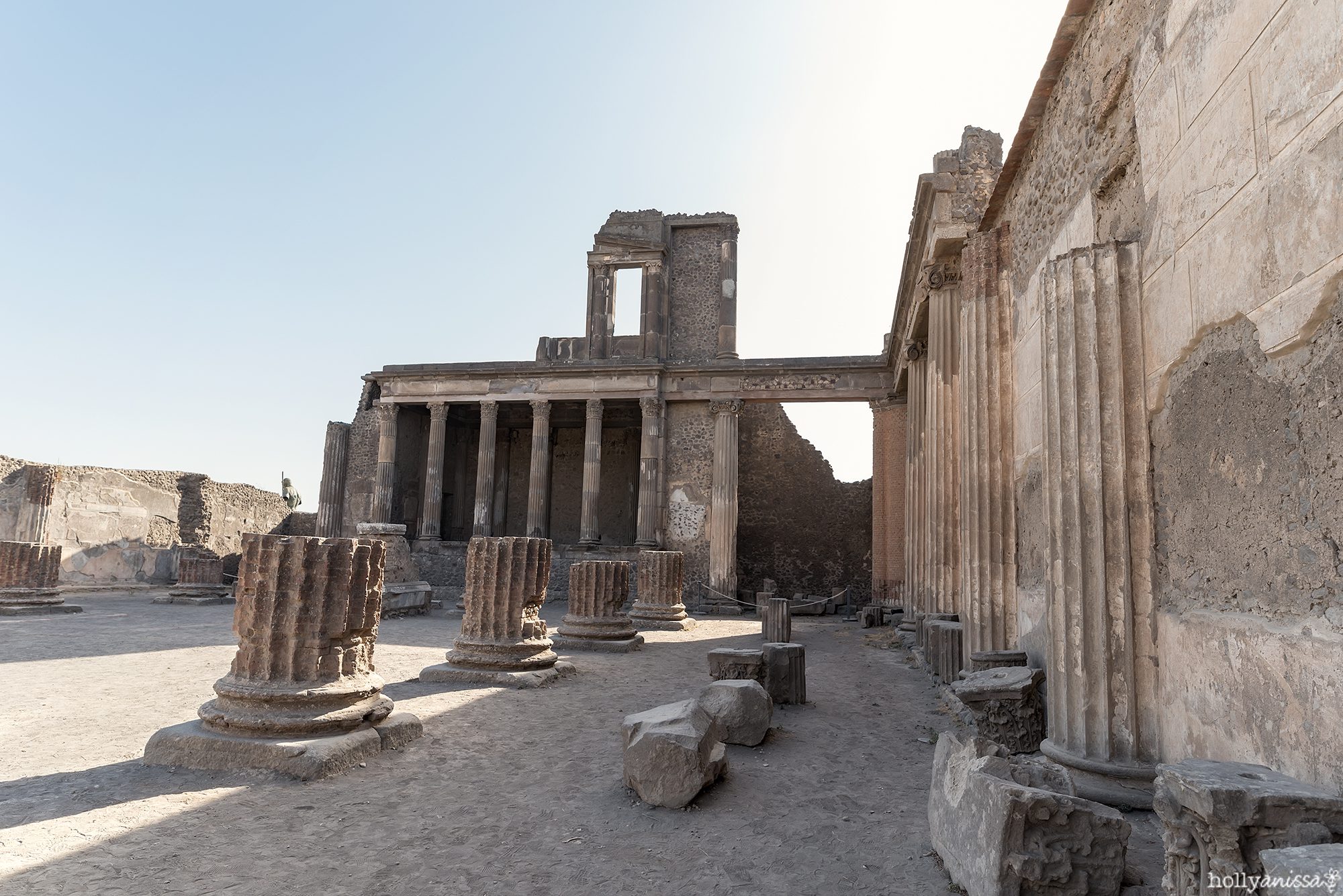
Nikon D750 | 20mm | f/5 | 1/320 | ISO 100
Curtis got this wonderfully composed image of the basilica ruins.
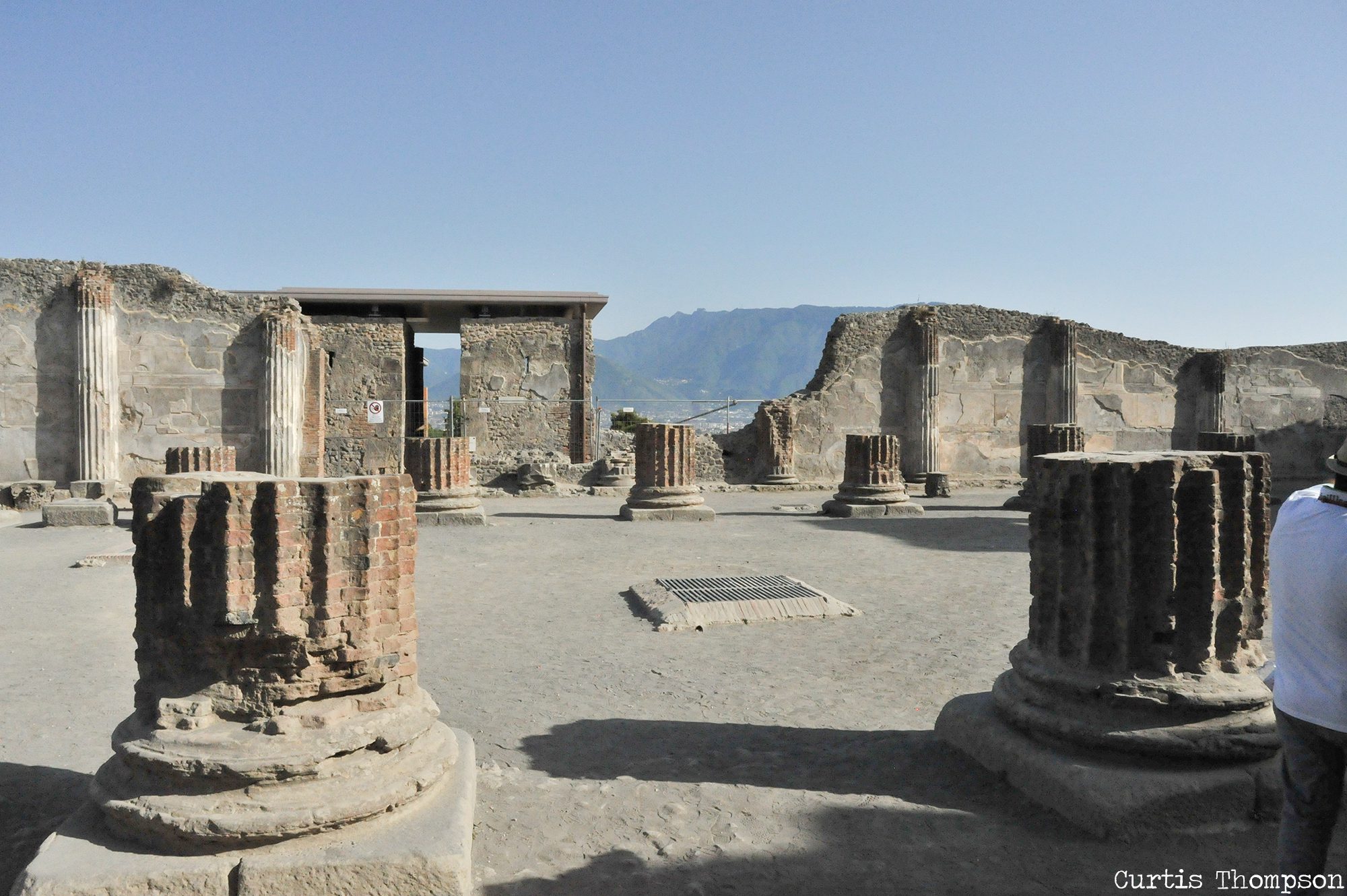
Nikon D700 | 24mm | f/22 | 1/2500 | ISO 4000
And a closer-in shot of the break in the wall.
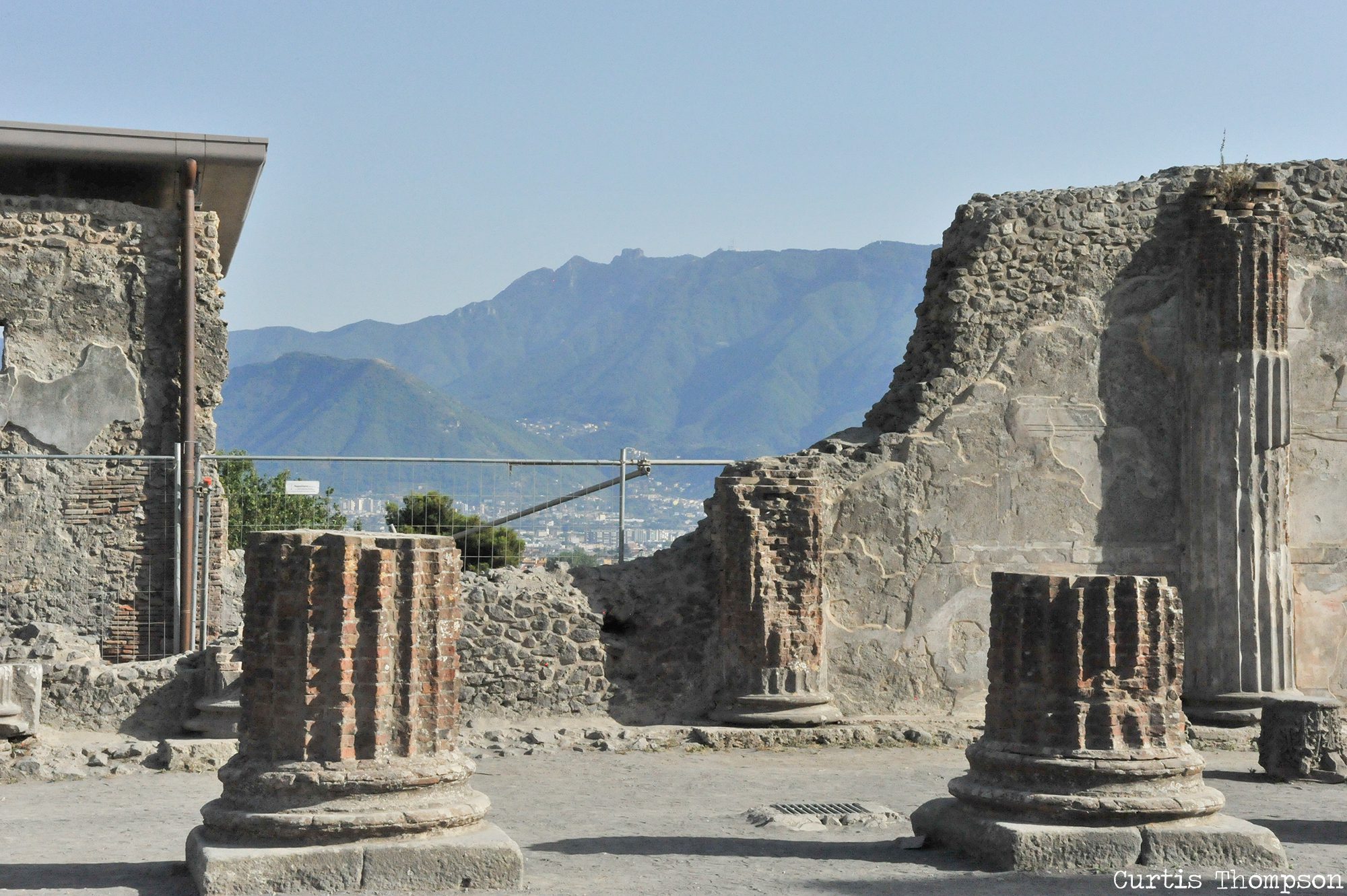
Nikon D700 | 62mm | f/22 | 1/2500 | ISO 4000
Then he turned around and got this gorgeous sun flare shot!

Nikon D700 | 24mm | f/22 | 1/500 | ISO 4000
Vesuvius Looms
As our formal tour came to an end, we stood near the original port looking toward Vesuvius (now this site is many miles inland). The volcano looks so innocuous. I thought of this ancient civilization… how incredibly sophisticated it was… and how grateful I was that we got to see so much of its complex life through these ruins. In today’s modern world, we take so much for granted and we are so sure we are “right” about so many things. I wonder what future generations will think of us. We were allowed to go back in and wander around Pompeii, but honestly the city was so big and it was so hot, we had seen enough.
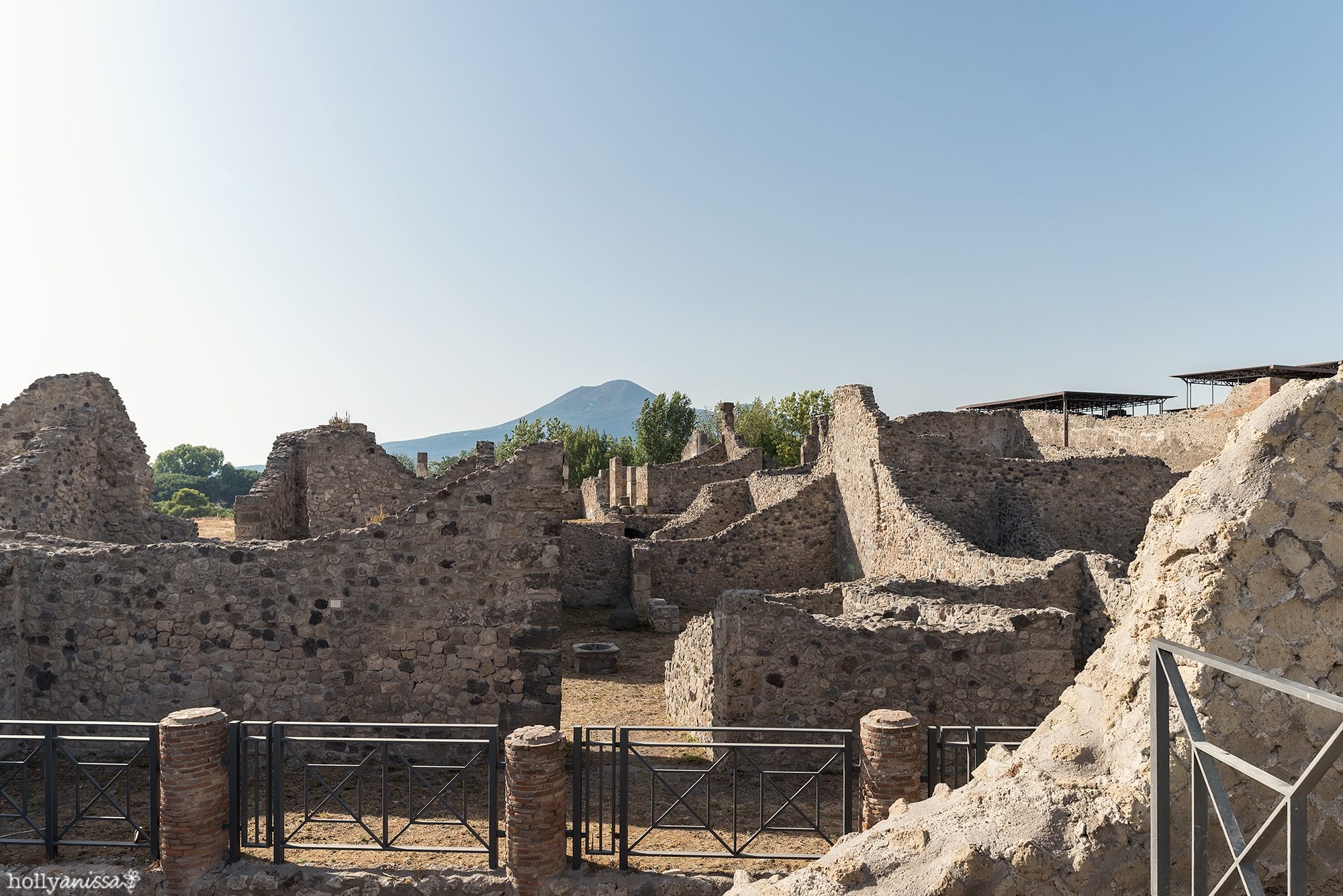
Nikon D750 | 20mm | f/6.3 | 1/320 | ISO 100
There was a traveling art show that had installation pieces all over Pompeii. Curtis didn’t know this wasn’t a real Pompeii artifact and stopped to get a photo. Lello hates these sculptures!
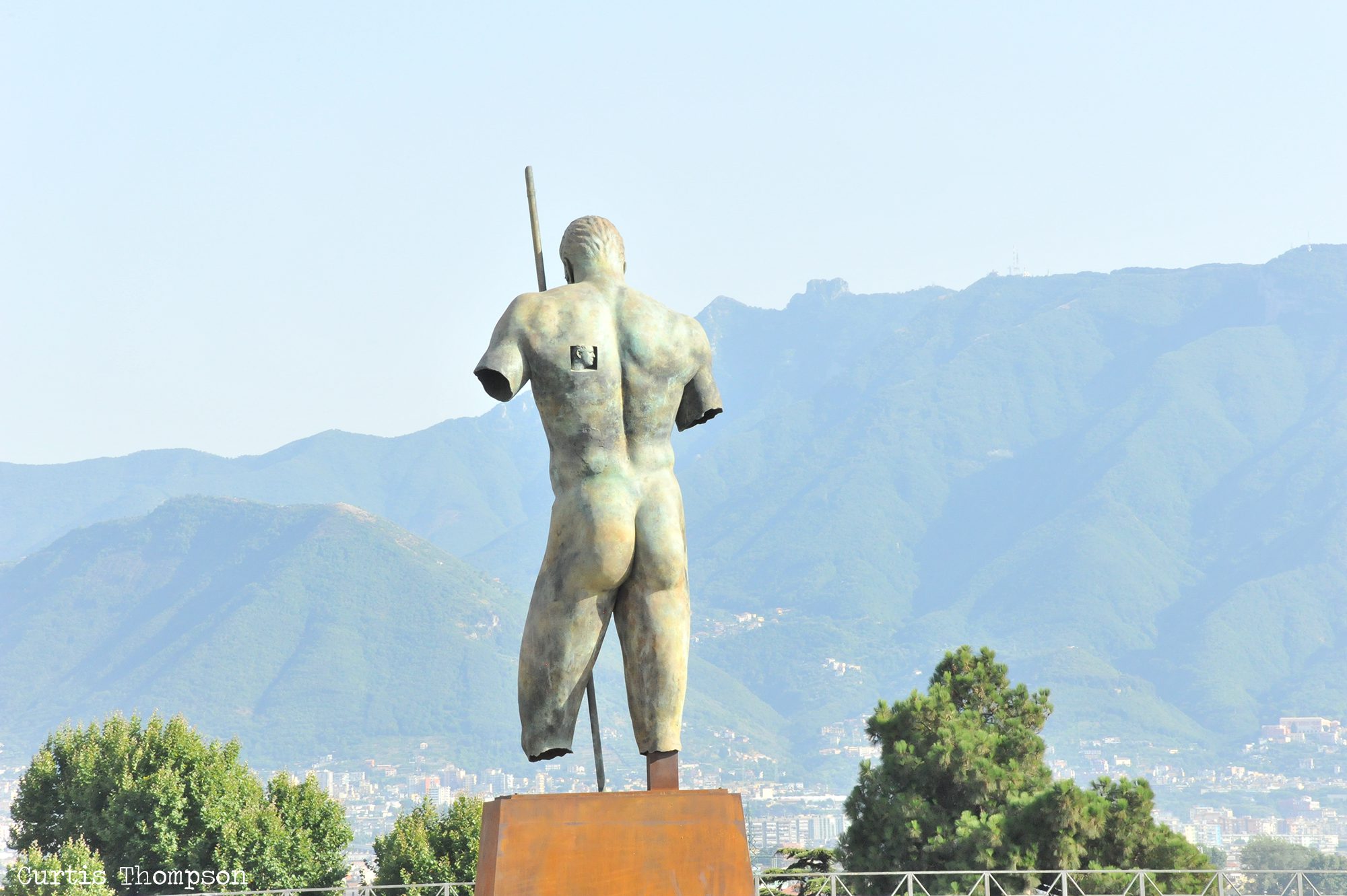
Nikon D700 | 120mm | f/22 | 1/500 | ISO 4000
Toward the City
This is a shot looking toward the modern city of Pompeii. The countryside is beautiful in this part of Italy. We finished the tour in about two hours and found our driver waiting in the visitor parking area. We went back to the hotel in Naples and freshened up before going out to dinner.
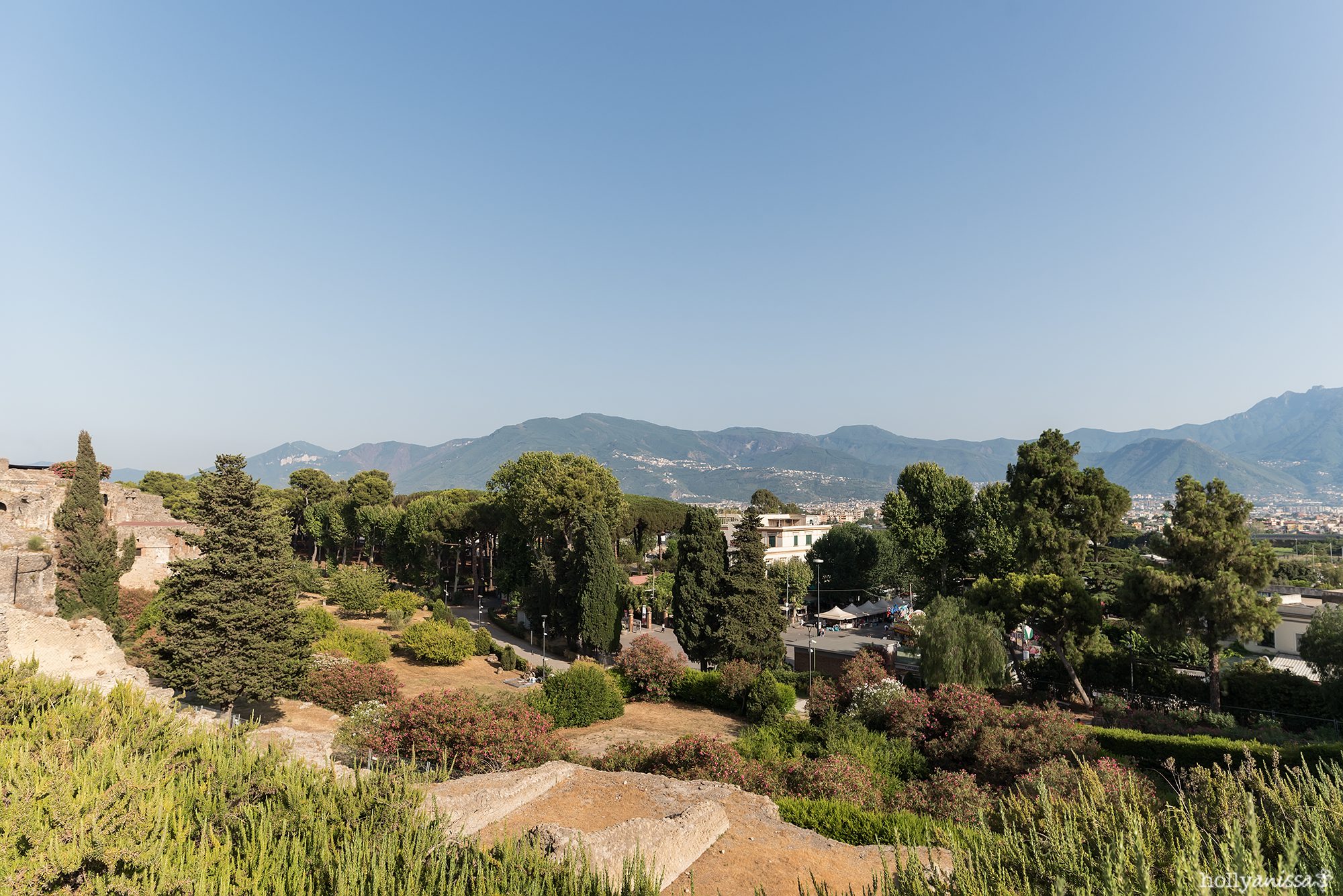
Nikon D750 | 20mm | f/6.3 | 1/320 | ISO 100
Ovo Castle
We asked the hotel staff for a dinner recommendation and they suggested Antonio and Antonio that was located on a long boardwalk section of the bay. We took a taxi down to the area and was overwhelmed with how many people were down there. It was crazy crowded! There weren’t many American tourists and lots and lots and lots of young Italian kids… think Jersey Shore meets The Real Housewives of New Jersey. Kids ages 9-15, wearing fancy clothes, lots of bling and jewelry, and most of them smoking. (Everyone smokes everywhere in Italy.) We wandered for a while down the boardwalk and saw this castle off in the distance. When we got home, I looked it up and discovered it was called the Castel dell’Ovo or Ovo Castle.
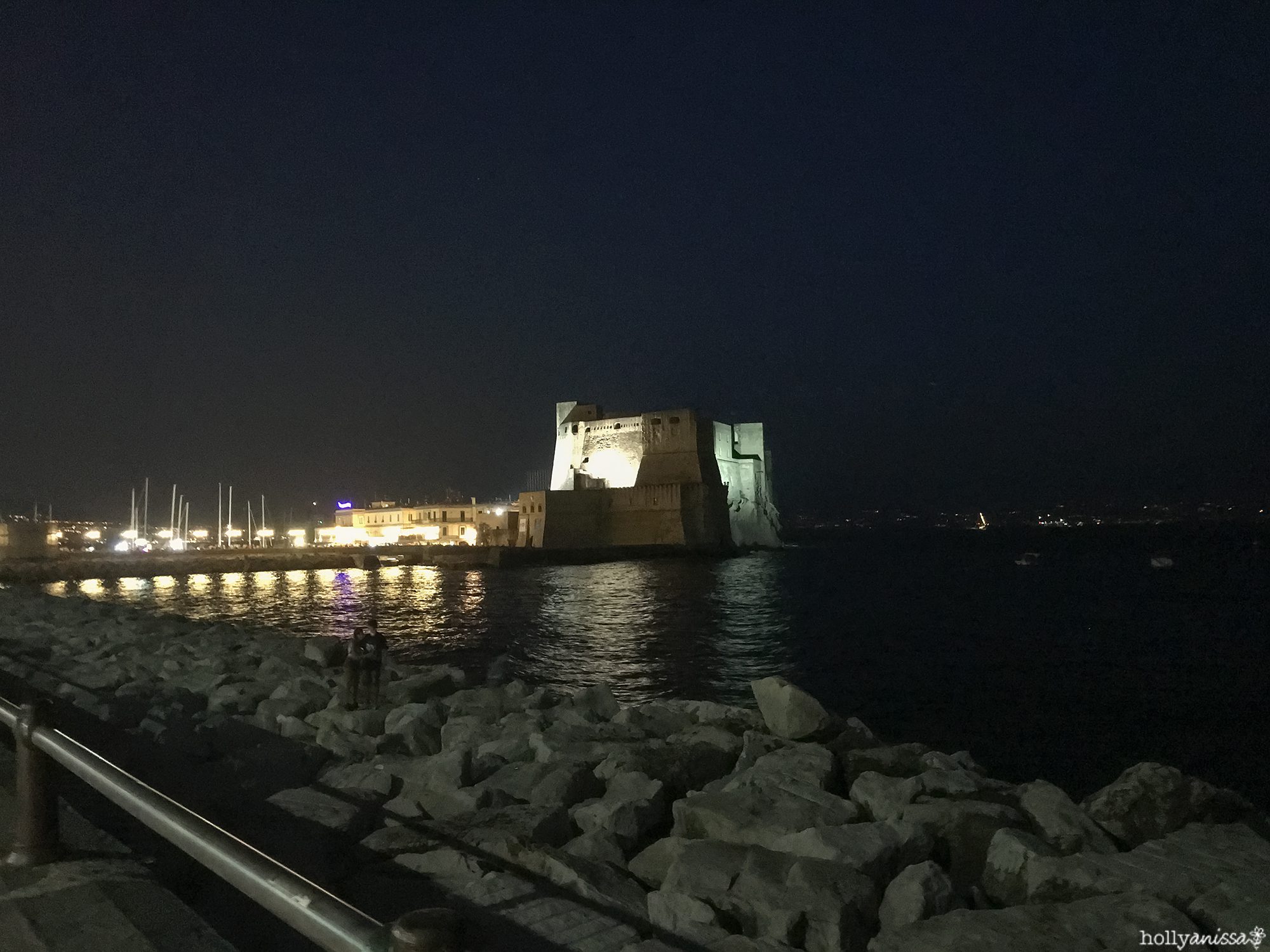
iPhone 6S+ | 4.2mm | f/2.2 | 1/4 | ISO 800 (+3.28)
Curtis got this shot of me getting a shot of Ovo Castle!
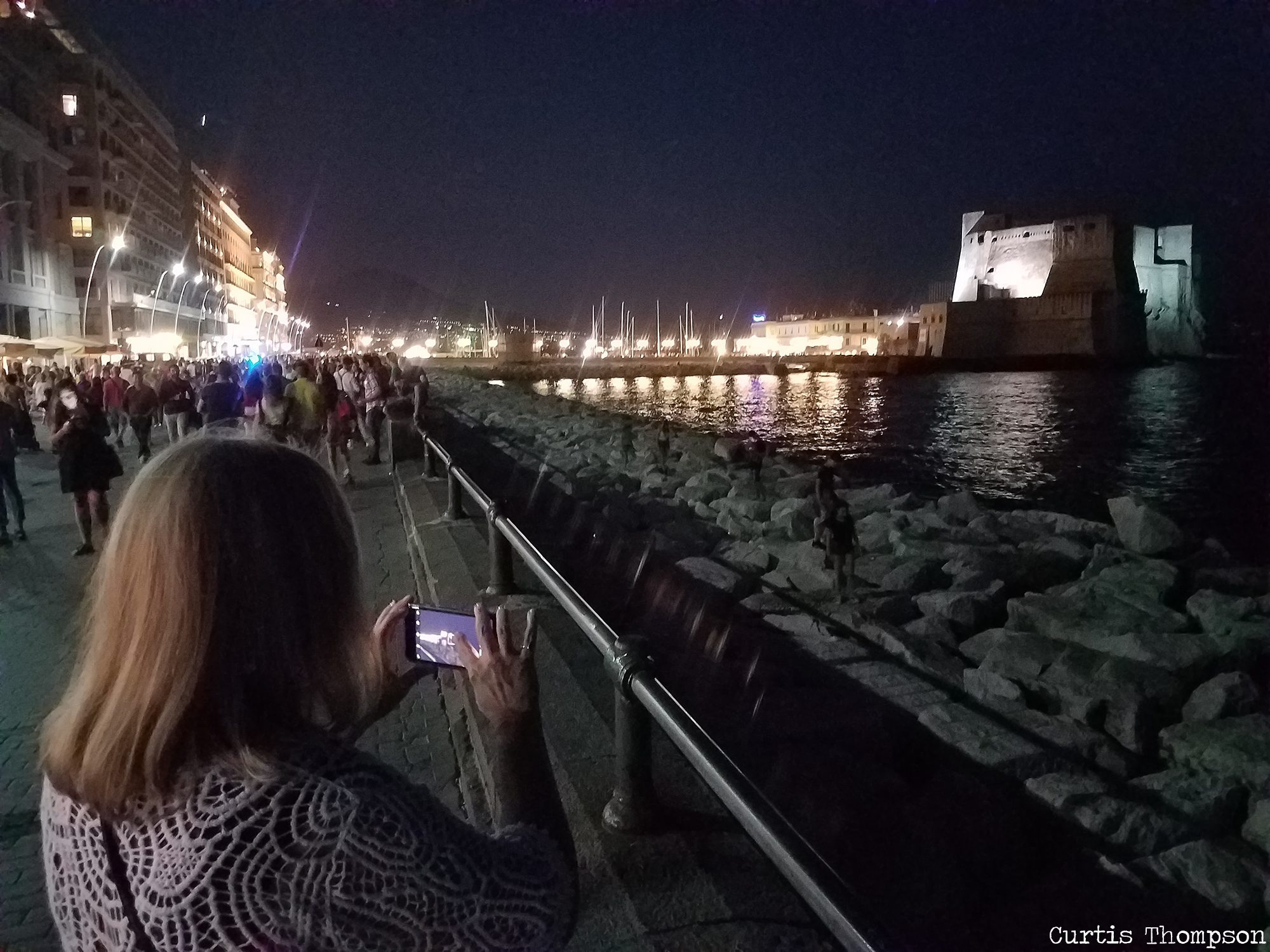
Samsung Galaxy 6
Dinner Entertainment
We had to wait about 10 minutes for a table at Antonio and Antonio but it was worth the wait. The seating was outside and there was so much to look at. Food was good, wine was great, and before too long a band wandered by and played for the crowd.
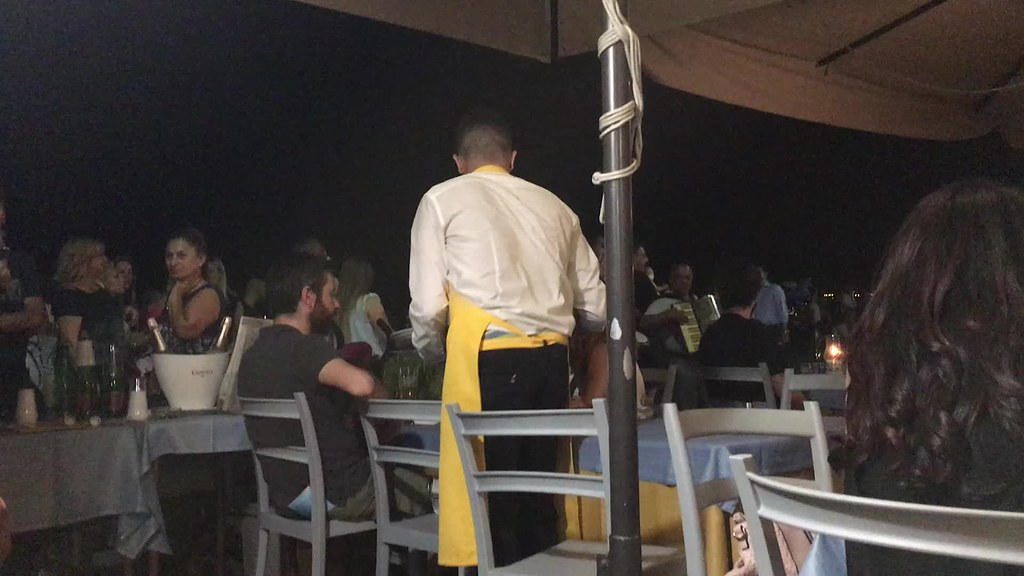
iPhone 6S+
Thanks for reading and for looking! Next week we will be sharing photos from our magical visit to Capri!
SaveSave
